Boat Navigation Lights Rules: Illustrated Beginners Guide
When navigating at night, the lights on other boats are your first clue about the moving dangers around you. And your navigation lights are your first line of safety in avoiding collisions in the dark, and they tell others vessels what you are and what you are doing. The rules sound complex, but with a little understanding you can get the basics for any situation.
So what are the basic navigation light rules? For most small vessels, motoring requires red and green (port and starboard) lights, and a white light visible in all directions around the boat. This is almost always a stern light and a masthead light on sailboats. Boats under sail require port and starboard lights, and a white stern light. Sailboats below sixty-five feet may show a tricolor light at the masthead instead of side and stern lights when sailing.
That's it, in a nutshell. There's a little more to it, as the rules change with different sizes and there are some specifics about angles of display for the colors. Identifying other ships at sea requires more study, but the basics are the same. And it's not much trouble to make sure you've always got the proper lights on your vessel.
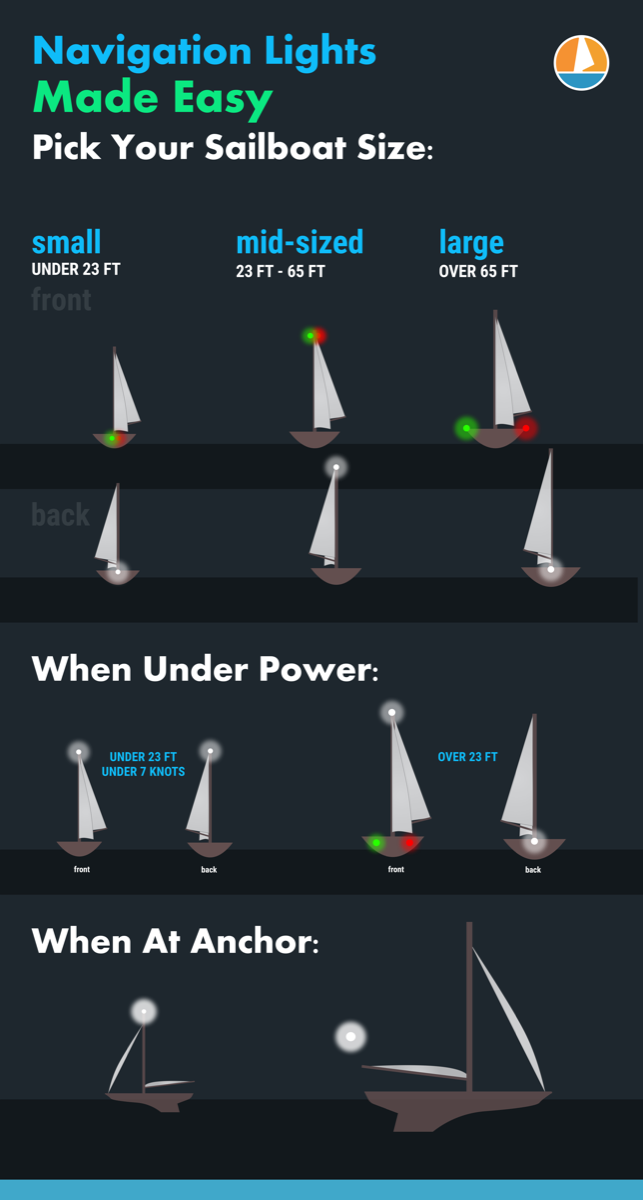

On this page:
What are the official colregs rules for your sailboat, what about the uscg (united states coast guard) rules, lighting at anchor, identifying the boats around you.
The International Regulations for the Prevention of Collision at Sea , abbreviated "COLREGS" is very specific about the lights required, their shapes and sizes, and the distance they must be visible. For the smaller boat, the following definitions apply.
- Masthead Light - a white light placed centerline on the boat showing an arc of 225 degrees with 112.5 degrees either side of the front of the vessel.
- Sidelights - A red light on the port side and a green light on the starboard. They must show an arc of 112.5 degrees from centerline of the bow.
- Stern light - A white light on the stern of the boat showing an unbroken arc of 135 degrees from centerline of the vessel.
- All-round light - A light showing in an unbroken arc of 360 degrees.
The good news is you need not measure these angles. Any properly installed USCG or COLREGS approved light which will cover the correct arcs. If you have to replace the original light from your boat, make sure it's with an approved replacement.
Lights When Sailing
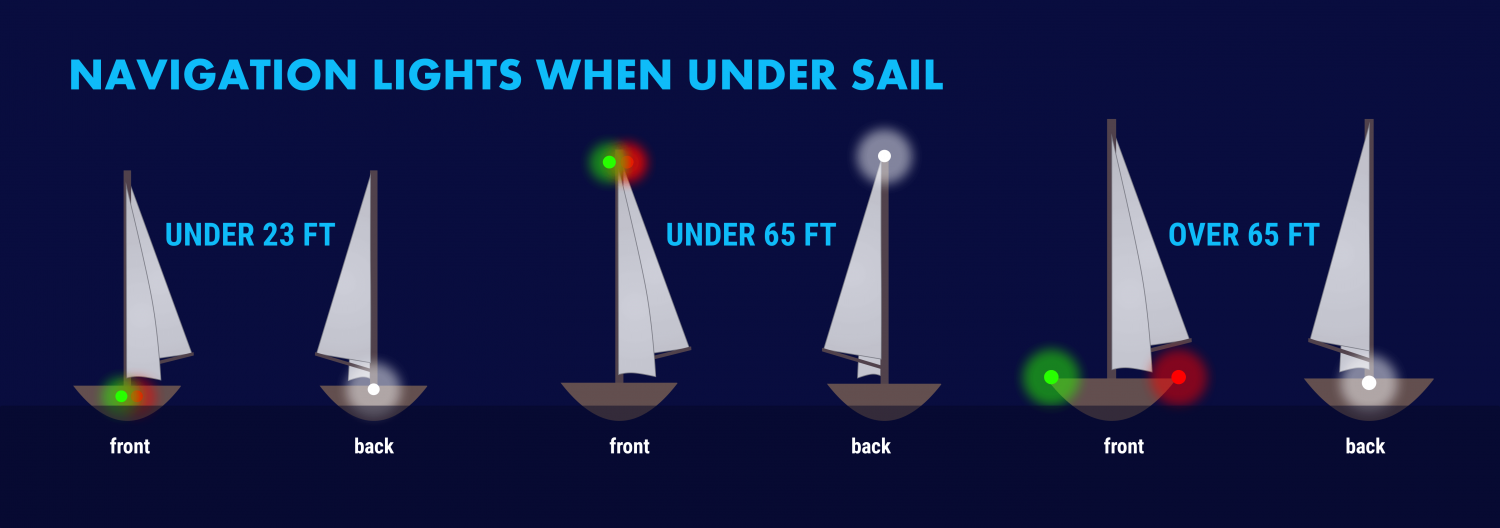
The specific rules for a sailboat under sail are in COLREGS Rule 25 and vary slightly with the size of the boat. A sailboat powering is considered a power boat and falls under in Rule 23.
- Under 23 feet (7 meters) - side lights and a stern light, possible. If these lights can not be displayed a light must be kept at hand to help avoid a collision. This can be a bright flashlight.
- Over 23 feet - Side lights visible to one nautical mile and stern light visible for two.
- Vessels under 65 feet may combine both sidelights into a single lantern on the bow.
- May show a tricolor light on the masthead instead of sidelights and a stern light. It's one or the other though, do not show these lights at the same time .
- Masthead light must be visible for three nautical miles, all other lights must have a two nautical mile visibility.
- Side lights must be separated.
- May not show a masthead tricolor light.
- Masthead light must have five nautical mile visibility, all other lights must be visible for two nautical miles.
- Optional masthead lights - any vessel under sail may display a red light over a green light at the masthead with sidelights and stern light. The red over green may NOT be displayed with a masthead tricolor light. It's one set or the other.
Lights When Motoring
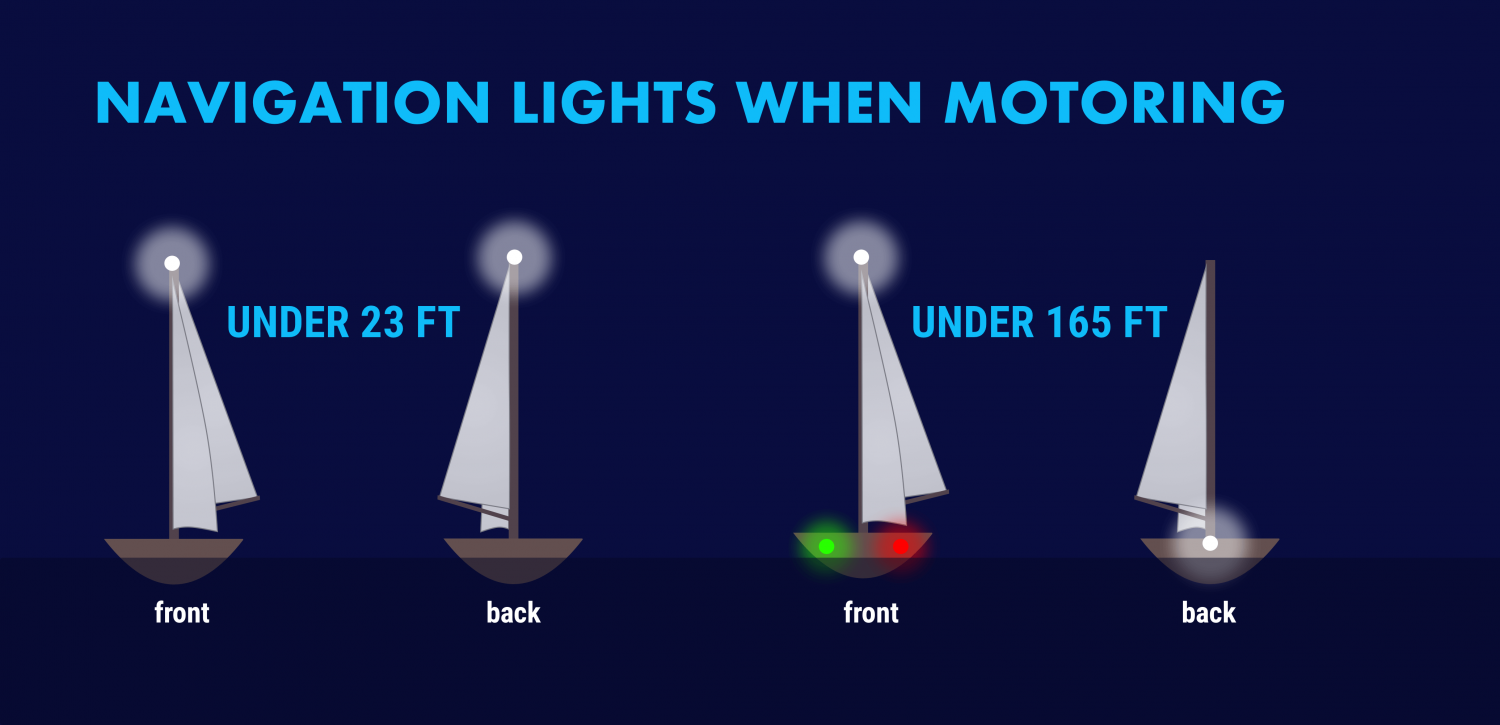
For all navigational purposes a sailboat under power is considered a power boat. This includes motor sailing - if the engine is on and providing propulsion you are on a power boat, even if the sails are up . This applies to navigation lighting, sound signals in fog and limited visibility, and rights of way.
Sailboats under 50 meters under power need to show:
- A masthead light
- Stern light
A power-driven vessel under 23 feet (7 meters) that does not exceed seven knots of speed may display an all around white light, though sidelights should be used if available.

The USCG has published its own "Rules of the Road" that are based on the COLREGS. In addition, it has rules for the "Inland Waterways" for rivers, inland lakes and the Great Lakes.
The good news is this has no impact on what you have to do with your own boat.
They mostly relate to lighting changes on towed vessels like barges and tugs. For example, a vessel towing or pushing another vessel in the ocean under COLREGS shows two masthead lights, sidelights and a stern light, whereas in Inland Waterways the towing or pushing vessel displays two yellow towing lights instead of a white stern light.
If you sail on lakes, rivers or the Great Lakes where towed commercial traffic is common you should learn the inland lights, but coastal or ocean sailors will never see these.
When you anchor outside a designated mooring field, you should display an all around white light at the masthead or as high in the boat as practical.
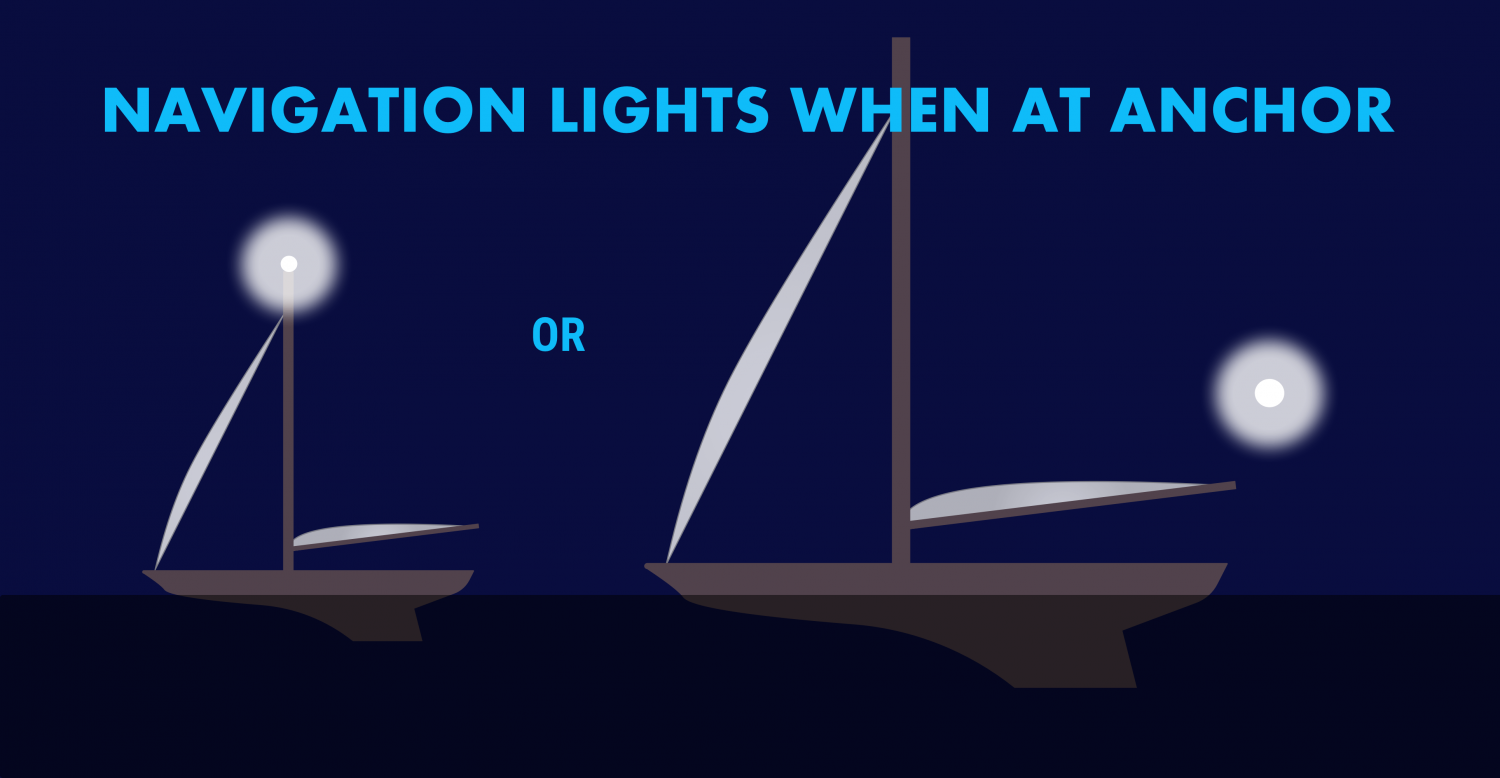
If your boat is large and has a very tall mast, you may wish to display another light closer to the waterline. Boats approaching in the dark may not see a light on a mast sixty or seventy feet in the air when they are close to your boat.
We use a simple garden path light on our stern when we anchor, left in a rod holder or flag socket. It comes on automatically at dusk and is a cheap and easy way to be more visible. There is no specific rule stating you can not display more lights than required, or the nature of any lights beyond the required all around light.
The COLREGS also specify that a round black "daymark" should be displayed in the rigging of any vessel at anchor. Very few small vessels observe this, however it is the correct display for a vessel in an anchorage.
If you tie to a mooring in a marked mooring area you are not required to display anchor lights, but there is no harm in doing so.
The other important reason to know your lights is to figure out what's going on around you at night. The water may be ablaze with white, red, green and other lights at night and they are your first key to avoiding collisions and problems.
All combinations of lights for fishing boats, commercial vessels, and so on are outside this post‘s scope. The odds are small you will encounter a submarine, seaplane or hovercraft at night, but there are regulations regarding specific lighting for each of those vessels!
There are a few fundamentals to help you figure out what that is you see on the horizon, which way it is going, and whether it is a danger to you.
Port Wine is Red
The fundamental rule is that red sidelights will ALWAYS be on the port side of a vessel, and green lights will always be on starboard. However, some vessels can use all around red and green lights for other purposes, though those will be higher than sidelights.

The light‘s on a ship is not important, some large tankers and freighters will have their sidelights far aft and put them on the superstructure for better visibility. It is not safe to assume that sidelights you can see are on the bow of large vessels .
When you can see the color, you know which way the bow is pointing. If it's red, it's pointing more or less to the left and will travel in that direction. A green light shows it is heading more or less to your right.
If you can see the red and green lights at the same time, you are looking directly at the bow of the vessel. When you are far away, this isn‘t as alarming as if you are close crossing. Seeing red and green lights together on a vessel is something you never want to see for long.
Be aware of red and green lights used in combination with other red, green and white lights. These may not be running lights and could have other significance.
Tankers, Freighters and Large Ships
Tankers, freighters and large ships will have side lights, a stern light and a masthead light. In addition, on vessels over 50 meters there will be a second masthead light further aft and higher than the forward light. The masthead light positions are a better tipoff to the bow direction and how far from the bow the sidelights might be. Remember - on a large vessel the sidelights may not be at the bow or even close to it.
USCG Inland Rules allow for a second all-around white light on large vessels on the Great Lakes instead of a second masthead light.
Fishing Boats
Fishing boats engaged in fishing will have more complex light displays. When they aren't fishing, they will show lights like any power vessel, but Rule 26 spells out light combinations that vary by the fishing activity being done. In general:
- Boats which are Trawling but not making headway will display a green all-around light over a white all-around light , and a masthead light aft of these lights. Boats making headway while trawling will show these lights, plus sidelights and a stern light.
- A vessel fishing other than trawling will show a red all-around light over a white all-around light . When making way they will also show sidelights and a stern light.
- If a vessel has gear more than 150 meters away from the boat, it will show a second all around light in the direction of the gear. The best rule is to give fishing boats as wide a berth as you can at night. They're easy to pick out if you check the top light configurations but their course may be difficult to predict.
Towing and Pushing
Towed vessels can be the most dangerous to cross, but they have the most lights to tell you what is happening. Refer to COLREGS or the USCG Rules of the Road Rule 24 for all combinations You can pick a tow/push vessel out with the following lights:
- Two or three masthead lights in a vertical line. Three masthead lights shows a tow over 200 meters. Additional masthead lights may show for larger tow vessels.
- A towing light (yellow light with the same characteristics as a stern light) directly above the stern light.
- The will also have side lights and a stern light.
- The towed vessel will show sidelights and a stern light. Lighting may vary under USCG inland rules, where towing lights may replace stern lights. Learn these differences if this is your regular cruising ground. If you think there is a tow ahead of you, always go well behind the aft most set of lights. Never go between a tow and avoid crossing ahead if possible as it may restrict their maneuverability.
Special Situations
There are several rare situations you may encounter. As a general rule, if there are a lot of lights and you don't understand them look for the sidelights on a moving vessel. If you can find them and figure out the direction it is moving, it makes the vessel easier to avoid. Stay well clear of lights you do not understand if you can avoid them without risk.
Most of these signals are used by larger, commercial vessels and you will not need them.
They use these light combinations with other light combinations. For example a towing vessel may also be restricted in maneuverability, and a vessel constrained by draft will show running lights if moving.
- Not Under Command - two all around red lights in a single line
- Restricted in Ability to Maneuver - red, white then red in a single line
- Constrained by draft - three all around red lights
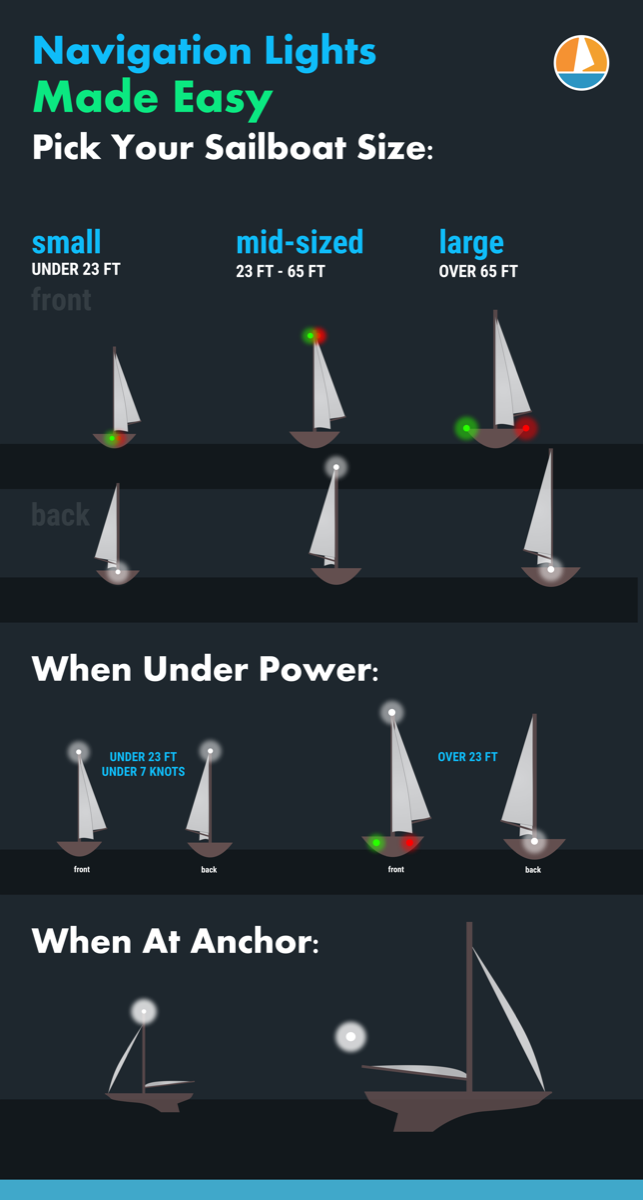
Leave a comment
You may also like, 17 sailboat types explained: how to recognize them.
Ever wondered what type of sailboat you're looking at? Identifying sailboats isn't hard, you just have to know what to look for. In this article, I'll help you.

The Ultimate Guide to Sail Types and Rigs (with Pictures)

Navigation Lights
- You are required to display the appropriate lights at night or during times of reduced visibility.
Navigation lights are used to prevent collisions at night or in times of reduced visibility, and are an essential tool in keeping you and your vessel safe. Nav lights allow you to see other nearby vessels, and allow other vessels to see you.
Nav lights also provide information about the size, activity, and direction of travel. By understanding the characteristics of Nav lights, you can determine an appropriate course of action as you approach another vessel.
On any vessel, navigation lights have a specific color, (white, red, green, yellow, blue), arc of illumination, range of visibility, and location, as required by law and regulations. For the purposes of this course, we will concentrate on pleasure boats under 65 feet in length. Knowledge of navigation lights is important to a small-boat skipper for separate, but important, reasons.
- You are legally responsible for displaying lights of the proper color, intensity, location and visibility on your boat.
- Knowing the type and heading of another boat.
Legal Requirements
Vessels are required to show the proper navigation lights from sunset to sunrise in all weather conditions, good and bad. During these times, no other lights that could be mistaken for lights specified in the Rules of the Road can be displayed, nor any lights that impair the visibility or distinctive character of navigation lights, or interfere with the keeping of a proper lookout. The Rules also state that navigation lights must be shown in conditions of reduced visibility, and may be shown at other times considered necessary.
It's Your Responsibility
It is the responsibility of the owner/operator of a vessel that she show the proper navigation lights for her size and the waters in which she is operating. It is not the responsibility of the manufacturer, importer, or selling dealer. Many boats are delivered with lights that do not meet legal requirements with respect to technical characteristics or placement on the vessel. Remember also, that the angles of visibility must be met when the boat is underway-if your boat rides at a significant bow-up angle, take that into consideration when installing and/or checking your lights.
Navigation Lights for Powerboats
Power driven vessels underway shall exhibit a masthead light forward, sidelights and a stern light. Vessels less than 12 meters in length may exhibit an all around white light and side lights. Power driven boats on the Great Lakes may carry an all around white light in stead of a second masthead light and stern light combination.

Sidelights - Colored lights - red on port and green on starboard - showing an unbroken arc of the horizon of 112.5 degrees, from dead ahead to 22.5 degrees abaft the beam on each side.
Combination lights - Sidelights may be combined in a single fixture carried at the centerline of the vessel.
Stern light - A white light showing over an unbroken arc of the horizon of 135 degrees, centered on dead astern.
Navigation Lights for Sailing
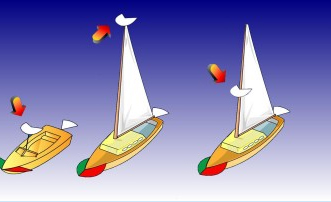
A sailing vessel of less than 7 meters in length shall, if practicable, exhibit regular navigation lights, but if not practical, she shall have ready at hand an electric torch or lantern showing a white light which shall be exhibited in sufficient time to prevent collision.
Diving Lights
Another light display that you may see in resort areas, or waters that have wrecks or reefs, is the night diving configuration. This has three vertical masthead lights, that have a red-white-red sequence. You must maintain a good distance from these vessels, and you should also be aware that there may be divers near you.
Interpreting what you see

It's great that you're learning the basics of lights - what is required and when they're required. But, this in only the beginning. You must also learn how to interpret the navigation lights that you see when you are underway at night- and for your safety-learn it well.
For instance, if you see a vessel approaching that shows a light pattern such as the ones to the right, you immediately know that you are in a crossing situation, and that you must yield to the other vessel - that's why it is red.

Seeing a green light over a white light indicates a fishing vessel actively trawling. You not only need to avoid the vessel, but you also need to remember that it could potentially have a very large net deployed that you will also need to avoid.
And there are numerous other lights and combinations of lights that you must be able to instantly recognize - the lights for a sailboat that is privileged over a motorboat, the special lights of various fishing vessels, a dredge or a vessel not under command. Study the requirements for navigation from the viewpoint of a "looker" as well as a boat owner.

Please verify you are a human
Access to this page has been denied because we believe you are using automation tools to browse the website.
This may happen as a result of the following:
- Javascript is disabled or blocked by an extension (ad blockers for example)
- Your browser does not support cookies
Please make sure that Javascript and cookies are enabled on your browser and that you are not blocking them from loading.
Reference ID: 67b6f637-666c-11ef-8fd7-7eb730c8a6d8
Powered by PerimeterX , Inc.
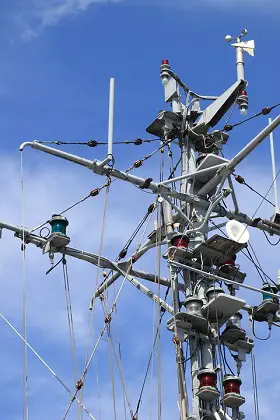
Boat Lights At Night (The Rules For Safety)
Boat navigation lights at night are used for safety. They are designed so they can be seen easily. Boat lights vary according to boat type and size, boat use, navigation area, and geographic location. Boaters should learn boat light meanings and keep up-to-date on boat light requirements.
Boat navigation lights indicate a boat’s heading (Aspect) and what it’s doing. The boat’s red and green lights show the boat’s port and starboard sides. Let’s explain boat light type, actions, and requirements in detail.
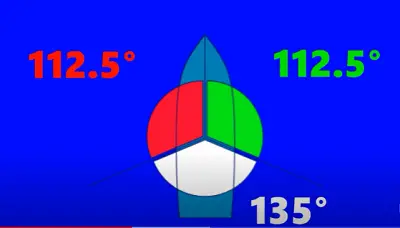
Types of Boat Lights
Boating safety starts with proper boat navigation lights. If you are a boater, it’s important to understand the 4 types of common navigational lights on your vessel so that you can be seen by other boats in the water and avoid accidents or running aground.
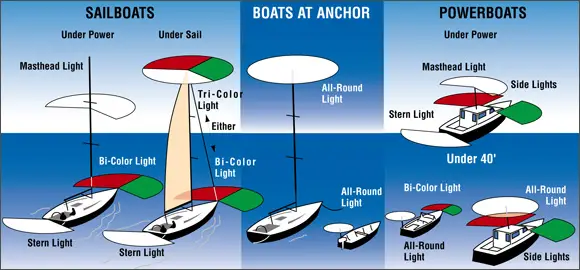
Boat navigation lights are split into four groups. There are Sidelights, Stern light, Masthead light, and All-Round light.
Sidelights show Red or Green to other vessels approaching from the side or head-on, while stern light only points out white light when you’re coming up behind someone else’s boat.
Masthead light should be mounted high on a vessel’s aft-most part of the structure that extends above deck level. The masthead light is a requirement on all power-driven vessels. It shines forward and to both sides and the color of this light is white.
The boat’s all-around white light is on the mast, stern, or somewhere else on the boat. This light can act as an anchor light when a boat is anchored.
Boat Navigation Light Color
- Masthead light color – White
- Port sidelight color – Red
- Starboard sidelight color – Green
- Stern light color – White
- All-Round light color – white
Boat Light Visibility Range (Minimum)
- Side lights; Boat < 12m (39.4 feet) – At least 1 NM
- Masthead light; Boat < 12m (39.4 feet) – At least 2 NM
- Stern light; Boat < 12m (39.4 feet) – At least 2 NM
- All-Round light; Boat < 12m (39.4 feet) – At least 2 NM
- Boat < 20m (65.7 feet) – Masthead light at least 3 NM; Other light at least 2 Nm
- Boat > 20m (65.7 feet) – Masthead light at least 5 NM; Other light at least 2 Nm
Boat Navigation Lights Indicate W hich Side ?
Your boat’s navigation lights will basically tell you what side of the vessel is a port and which side is starboard. The red light indicates a vessel’s port (left) side; the green indicates a vessel’s starboard (right) side. Stern light is seen only from behind or nearly behind the vessel. Masthead Light shines forward and to both sides.
What Are Boat Lights Used For ?
Boat lights are typically used to guide boaters at night, but they can also be used for a number of other purposes. They can help you and other boaters determine which is the give-way vessel when encountering each other on the water during periods of restricted visibility such as fog or rain. So never forget boat lights at night — boat lights make you and others visible at night on the water. They are used only for boat safety purposes.
Boat Lights and The Law
To navigate safely in the water, vessels are required to show proper navigation lights. There’s no need to worry about boat lights being an inconvenience because they must be displayed from sunset to sunrise and during periods of limited visibility.
You must turn on boat lights when underway between sunset and sunrise, as well as during any period of restricted visibility such as fog, rain, or heavy snowfall. And when it is deemed necessary by any boat skipper, boat lights must be turned on during the day.
Why Do Boats Have Blue Lights?
The reason boats have blue lights is to signify that they are law enforcement vessels. They may display a flashing blue light when engaged in direct law enforcement or safety activities, so as not to interfere with the visibility of their navigation lights.
What Does a Single White Light on a Boat Tell You?
When you see a single white light on the horizon, it may mean that you are overtaking another vessel. In order to avoid collisions and other mishaps, give way to either side of the boat. Also, one single white light could mean that the other boat is at anchor.
What Does a Red Flashing Light Mean on a Boat?
A red flashing light means that it’s a WIG boat.
What Size Boat Requires a Stern Light?
If your boat is 39.4 feet or longer, make sure to get a separate masthead light and stern light. However, If you’re on a power-driven boat less than 39.4 feet in length, then the masthead and stern light may be combined into a single all-round (360 degrees) white light.
Where to Put Navigation Lights on a Boat?
- Masthead – over the centerline of a boat (seen ahead from 225 degrees)
- Stern – near the stern, lowest height on a boat (seen 135 degrees from behind)
- Side – port/left side and starboard/right side (112.5 degrees sides arc)
- All-round – over the centerline of a boat (360 degrees arc)
Safety Tips When Using Boat Lights
– Must be turned on when underway between sunset and sunrise
– Should be turned on when in poor visibility
– Must be turned on when deemed necessary
– Must be mounted in such a way that boat lights are not obscured by any other obstructions
– Used for boat safety only
– Can never be used as floodlights
– Must be mounted in such a way that the other boat operator can see them clearly
– Should be properly illuminated at all times
– Must be mounted securely
– Must never be covered by boat covers or other obstructions
– Should be turned off when a boat is at anchor (Turn on anchor light)
Boat lights are more than just a way to see where you’re going at night. They can be used to communicate with other boats, and they can help you avoid collisions.
Boat lights are essential for safe night boating. They help other boats and vessels see your boat, and they also help you see where you’re going. There are different types of boat lights available, and it’s important to choose the right ones for your vessel.
What Are the Most Popular Boat Lights?
Here’s a look at some of the most popular boat lights and what they offer.
LED Boat Lights: LED boat lights are becoming increasingly popular due to their energy efficiency and long lifespan. They’re also much brighter than traditional incandescent bulbs, making them ideal for night boating. Many LED boat lights come in waterproof versions, so you don’t have to worry about them getting wet if you encounter rough waters.
Solar Boat Lights: Solar boat lights are a great eco-friendly option since they’re powered by the sun. They typically have built-in batteries that store solar energy during the day so that the light can shine at night.
Battery-Powered Boat Lights: Battery-powered boat lights are another popular option, especially for smaller boats. These lights typically use either disposable or rechargeable batteries, depending on your preference. Some battery-powered models even come with solar charging capabilities, so you can keep them charged even when there’s no sun available.
What Lights Should Be on When Boating at Night?
There are many different types of lights (including navigational lights) that are required or recommended to be used when boating at night. The type of vessel, the size of the vessel, and the area in which the vessel is operating will all play a great role in what specific lights need to be used. In general, however, there are a few basic rules that apply to all kind of vessels.
All these requirements exist so that other boats can easily identify your vessel and know its intentions (whether it is stopped, coming towards them, or moving away). By following these simple guidelines you can help keep everyone safe on the waterway.
Which Side of a Boat Has a Red Light at Night?
The side of a boat with a red navigation light at night is the port side. The port side is the left side of the boat when you are facing forward.
When Boating at Night What Does a Single Green Light Mean?
When you see a single green light, be sure that you are approaching a sailing vessel. In this case, you have to take action and you must give way. Remember, A sailing boat is always the stand-on mode except when it is going to overtake you.
What Lights are Required on a Boat at Night in Florida?
In Florida, boaters are required to display a white light visible in all directions from sunset to sunrise. Boats must have a white light visible from 360 degrees whenever they are safely moored or anchored away from jetty.
Leave a Comment Cancel reply
Save my name, email, and website in this browser for the next time I comment.
Sailboat Navigation Lights: A Guide to Safe Nighttime Sailing
by Emma Sullivan | Jul 26, 2023 | Sailboat Maintenance

==Short answer sailboat navigation lights:== Sailboat navigation lights are essential safety features that help vessels communicate and avoid collisions at night. These lights, such as the red and green sidelights and white stern light, allow sailors to determine the direction and status of approaching boats.
Understanding the Importance of Sailboat Navigation Lights
Sailing, with its air of romance and adventure, is a timeless pursuit that has captured the hearts of seafarers for centuries. While sailing enthusiasts revel in the sense of freedom and connection with nature that this activity provides, it is crucial to recognize that safety should always be a top priority when out on the open water. Among the many precautions taken to ensure safe navigation, sailboat navigation lights play an essential role.
These lights serve as beacons in the darkness, guiding both sailors and other vessels on their watery voyages. They are particularly vital during low visibility conditions such as fog, twilight, or nightfall when discerning a sailboat’s presence can be challenging. By understanding the importance of sailboat navigation lights, sailors can take proactive steps towards avoiding collisions and mishaps while enjoying their time at sea.
First and foremost, these lights serve as a communication tool between vessels. Just as traffic signals guide drivers on roads, sailboat navigation lights communicate a vessel’s navigational status to others nearby. These lights convey critical information about a boat’s direction of travel and whether it is under power or relying solely on wind propulsion. This enables other boats to predict potential collision courses and adjust their own paths accordingly.
In terms of regulatory compliance, having properly functioning navigation lights is not just recommended; it is required by international maritime laws like The International Regulations for Preventing Collisions at Sea (COLREGS). These regulations provide clear guidelines for different types of watercraft around the world to standardize safety measures. Following these rules ensures that every sailor speaks the same language when at sea, diminishing misunderstandings and encouraging mutual respect among mariners.
Furthermore, sailboat navigation lights contribute significantly to situational awareness – an invaluable asset in any seafaring endeavor. By displaying specific colors and configurations such as red/green sidelights and a white stern light visible from 135 degrees, sailors can discern the orientation of approaching vessels even in complete darkness. This knowledge empowers sailors to make informed decisions about altering their course or speed to avoid potential dangers.
In addition to enhancing navigation safety, sailboat navigation lights also add a touch of elegance and charm to nighttime voyages. Picture yourself sailing under a summer moonlit sky, with the soft glow of your vessel’s navigation lights casting mesmerizing reflections on the water’s surface. These lights not only provide reassurance but also create an enchanting ambiance for both sailors and onlookers.
While it may be tempting to dismiss the importance of sailboat navigation lights as just another cumbersome boat regulation, understanding their indispensable role is crucial for every sailor’s peace of mind and for ensuring uninterrupted enjoyment of our beloved pastime. So next time you set sail, remember that these little beacons serve as more than mere accessories – they are your allies in darkness, silently guiding you towards safe passages and unforgettable adventures on the open sea.
How to Properly Install and Operate Sailboat Navigation Lights
When it comes to sailing, safety should always be a top priority. And one of the essential safety measures on a sailboat is proper navigation lighting. Sailboat navigation lights help other vessels identify your boat’s position and course, especially during low visibility conditions or at night. In this blog post, we will guide you through the correct installation and operation of sailboat navigation lights to make your sailing adventures safe and enjoyable.
Installing sailboat navigation lights may seem like a simple task, but there are several key factors to consider for optimal functionality. First and foremost, familiarize yourself with international regulations regarding navigation lights. These regulations ensure consistency across different countries and improve communication between vessels on the water.
Before starting the installation process, carefully choose high-quality LED lights specifically designed for sailboats. LEDs offer numerous advantages over traditional incandescent bulbs, including energy efficiency, higher light output, longer lifespan, and reduced heat emission. Additionally, LEDs are more durable and resistant to vibrations commonly experienced while sailing.
To begin installing your sailboat navigation lights:
1. Determine the appropriate locations: Positioning your navigation lights correctly is crucial to maximize their visibility and effectiveness. Refer to your boat’s owner’s manual or consult with a marine electrician to identify the ideal mounting points for each light.
2. Prepare wiring routes: Plan out the wiring routes before drilling any holes or mounting fixtures. Concealing wires within the boat’s structure not only enhances aesthetics but also minimizes potential damage caused by exposure to external elements.
3. Drill strategically: Using an appropriately sized drill bit, carefully create mounting holes following the instructions provided by the manufacturer of your chosen navigation lights.
4. Connect electrical components: Install a waterproof junction box near each light fixture to protect wires from moisture and corrosion. Make connections following color-coded standards (red wire – positive; black wire – negative), ensuring proper polarity is maintained throughout the circuit.
5. Securely attach fixtures: Once all wiring connections are made, attach the navigation light fixtures to their designated mounting positions. Double-check that they are secure and properly aligned to maintain optimal visibility.
With your sailboat navigation lights installed, it’s time to understand their operation. Different situations call for specific combinations of lighting:
1. Underway with power: When sailing under engine power, display both a red (port side) and a green (starboard side) light visible from dead ahead to 22.5 degrees abaft each beam. A white stern light should also be shown.
2. Sailing without power: When solely relying on wind propulsion, display just the red and green sidelights in the same manner as during powered navigation.
3. At anchor: If you’re moored or anchored, only exhibit an all-around white light at a location high enough to illuminate unobstructed from every angle.
4. Restricted maneuverability: In situations where your sailboat’s maneuverability is impaired (e.g., towing another vessel), use three shapes—two balls vertically aligned above one diamond—to indicate restricted movement.
Lastly, always ensure proper maintenance of your sailboat navigation lights:
1. Regularly inspect for damage: Routinely check for signs of wear and tear on the electrical connections, housing seals, lenses, and reflectors. Replace any damaged components promptly.
2. Clean for maximum visibility: Keep lenses clean from dirt, grime, salt residue, or any other obstructions that could limit the effectiveness of your navigation lights.
3. Carry spare bulbs/batteries: Be prepared by carrying backup LED bulbs or batteries in case of failure during extended voyages.
By following these installation steps, understanding proper operation techniques according to maritime regulations, and maintaining your navigation lights diligently; you can cruise confidently knowing your sailboat is equipped with highly visible and functional navigation lighting system—an important feature enhancing safety while enjoying the open water at any time of day or night. So, set sail with peace of mind and navigate the seas safely while embracing the thrilling adventures that await you!
Step-by-Step Guide: Setting Up Sailboat Navigation Lights for Safe Sailing
Welcome aboard, fellow sailors! Today, we are going to dive into the nitty-gritty of setting up sailboat navigation lights for safe sailing. As you know, proper navigation lights are an essential part of ensuring your safety on the water, especially during low-light conditions and at night. So grab your cup of coffee, sit back, and prepare to learn how to illuminate the seas like a professional.
Step 1: Know Your Lights Before we jump into the technicalities, let’s familiarize ourselves with the different navigation lights required on a sailboat. These include the red port light on the left side, green starboard light on the right side, white stern light at the rear, and if our boat is longer than 20 meters (or 65 feet), a white masthead light at its highest point. Having this knowledge sets you up for success in navigating effectively while abiding by maritime regulations.
Step 2: Choose Your Lighting System Now that we’ve covered the basics, it’s time to decide which lighting system is most appropriate for your sailboat. You have two options: traditional incandescent bulbs or modern LED lights. While both serve their purpose well, LED lights are more energy-efficient and tend to last longer – a win-win situation!
Step 3: Gathering Materials To ensure smooth sailing throughout this process (pun intended), gather all necessary materials beforehand. This includes navigation lights (either incandescent bulbs or LED lights depending on your preference), wiring connectors, heat shrink tubing (to protect connections from moisture), electrical tape, wires (preferably color-coded for easy identification), wire strippers/cutters, and mounting hardware suitable for your boat.
Step 4: Planning Placement Consideration of placement plays a crucial role in setting up navigation lights effectively. Ensure visibility from all angles without obstructing other boat equipment or compromising aesthetics onboard. Take note of any manufacturer guidelines provided with your purchased lights for optimal placement. Remember, safety doesn’t mean sacrificing style!
Step 5: Wiring Your Lights Now we’re getting hands-on! Let’s start with the stern light. Attach the wires of your chosen light to the existing electrical system using appropriate connectors and ensure a secure connection. Utilize heat shrink tubing and electrical tape to safeguard against any moisture-induced malfunctions. Repeat this process for both port and starboard lights.
Step 6: Don’t Forget the Masthead Light If your sailboat exceeds 20 meters in length, you’ll need a masthead light too. Carefully mount this light on top of your mast using suitable hardware. Then, run additional wires through the mast to connect it securely with your electrical system.
Step 7: The Proof is in Testing After successfully wiring all navigation lights, it’s time for a crucial step – testing! Double-check that all connections are secure and operational before venturing out onto the open water. Be meticulous; don’t let a faulty bulb ruin your sunset cruise or impede your journey under a moonlit sky.
Congrats, sailors! You’ve now mastered the art of setting up sailboat navigation lights for safe sailing. Remember, maintaining these lights should be an essential part of regular boat maintenance as well. With proper illumination, maritime rules adhered to diligently, and cautious seamanship skills mastered, you can enjoy many breathtaking nights on tranquil waters without compromising safety. So go forth into the starry night with confidence and raise anchor towards new horizons! Bon voyage!
Frequently Asked Questions About Sailboat Navigation Lights, Answered!
Title: Frequently Asked Questions About Sailboat Navigation Lights, Answered!
Introduction: Navigating a sailboat safely and responsibly requires understanding and adhering to various rules and regulations. One vital aspect of sailing is ensuring proper use of navigation lights. These lights not only aid in visibility but also help communicate with other vessels on the water. In this blog post, we will delve into frequently asked questions about sailboat navigation lights, offering detailed professional answers infused with wit and clever insights.
1. Why are navigation lights necessary for sailboats? Navigation lights serve as visual signals that enable sailors to identify vessel types, positions, and movements at night or in low visibility conditions. They are crucial for promoting safety on the water by helping prevent collisions and aiding in the communication between boats.
2. What are the different types of navigation lights found on a sailboat? Sailboats typically feature three main navigation lights: red (portside), green (starboard side), and white (stern light). The red light tells other sailors that your boat’s portside is facing them, while the green light indicates that your starboard side is visible. The white stern light illuminates the rear of your vessel, making it easier for others to determine your direction of travel.
3. When should I turn on my sailboat’s navigation lights? According to international rules of collision avoidance at sea, all vessels must show proper navigation lighting between sunset and sunrise or during periods of restricted visibility such as fog or heavy rain showers. It’s essential to remember that even during daylight hours if visibility drops due to poor weather conditions, switching on navigational lights can greatly enhance safety.
4. Are there any additional requirements regarding sailboat navigation lighting? Yes! Aside from displaying the three main distinct navigation lights mentioned above, it is crucial for sailboats under power or motorsailing – using engine power alongside sails – to display an additional white forward-facing masthead light apart from the stern light. This masthead light helps identify the sailboat as a power-driven vessel, providing further clarity to nearby boaters.
5. Can I use LED lights for navigation purposes on my sailboat? Absolutely! In fact, LED lights are highly recommended for their energy efficiency and prolonged lifespan compared to traditional incandescent bulbs. However, it is essential to ensure that any LED navigation lights you use adhere to relevant maritime regulations concerning color, visibility range, and intensity.
6. How can I check if my sailboat’s navigation lights are working correctly? Regular maintenance and testing of your navigation lights are vital to guarantee their functionality when needed the most. Before every outing, visually inspect each light for signs of damage or corrosion. Additionally, switch on all navigational lights while docked or at anchor to verify they illuminate brightly according to the appropriate standards laid out in navigational lighting regulations.
Conclusion: Understanding sailboat navigation lighting not only ensures your safety but also promotes effective communication with other vessels on the water. By knowing when and how to properly utilize these lights, you contribute to maintaining a harmonious sailing environment. Remember, navigating with wit means being informed and cleverly enhancing your skills as a sailor while keeping safety at the forefront of your adventures!
Top Tips and Best Practices for Maintaining Sailboat Navigation Lights
Maintaining Sailboat Navigation Lights: Expert Tips and Best Practices
Picture this – you’re out on the open water, gliding along with the wind in your sails. As the sun dips below the horizon, darkness begins to envelop your sailboat. This is when maintaining proper navigation lights becomes paramount for both safety and legal compliance. In this blog post, we will dive deep into top tips and best practices for ensuring that your sailboat’s navigation lights are not only functioning but also showcasing their brilliance.
1. Regular Inspections are Key: To ensure your sailboat navigation lights are in prime condition, regular inspections should be conducted. Make it a habit before every trip to thoroughly examine all lights, from bow to stern. Look out for any loose connections, cracked lenses, or water intrusion that could hamper their effectiveness.
2. Ensure Proper Power Supply: One common issue faced by sailors is inadequate power supply to navigation lights, leading to dimness or complete failure at crucial times. Check that the wiring system is correctly connected and working optimally. Additionally, consider installing a voltage monitor or battery analyzer to keep tabs on power levels during extended journeys.
3. Choose LED Lights: When it comes to choosing sailboat navigation lights, opt for LED technology without hesitation. LEDs offer brilliant luminosity while consuming minimal power compared to traditional incandescent bulbs. Their longevity and durability make them ideal for equipping your vessel’s masthead light, sidelights, stern light, and anchor light.
4. Cleaning is Essential: Navigation lights on a sailboat accumulate dirt and grime over time due to exposure to various elements like saltwater spray or bird droppings (we all know how seagulls love making our boats their restroom). Regularly clean the lenses with a soft cloth and mild soap solution followed by drying with a lint-free towel. Keeping them crystal clear will maximize their output and visibility range.
5. Protect Against Moisture: Water ingress can be a persistent menace, harming the functionality of your sailboat’s navigation lights. To combat this, ensure watertight seals around light fixtures and wiring connections. Applying silicone lubricant or dielectric grease to connectors further enhances protection against moisture.
6. Carry Spare Bulbs and Fuses: Murphy’s Law states that anything that can go wrong, will go wrong – especially in the middle of nowhere. Imagine how disheartening it would be if one of your navigation lights suddenly fizzles out on a moonless night! Always carry spare bulbs and fuses suited for your specific lighting system to avoid such predicaments and keep your journey uninterrupted.
7. Stay Familiar with Navigation Regulations: Being updated on marine regulations regarding navigation lights is not only essential for your safety but also ensures compliance with local laws. These regulations dictate the placement, colors, and timings for displaying navigational lights based on different conditions such as underway, anchored, or sailing near other vessels at night.
In conclusion, maintaining sailboat navigation lights might seem like a mundane task; however, its significance cannot be undermined when it comes to safety during nighttime voyages. Regular inspections, adequate power supply, LED technology adoption, cleanliness, moisture protection, carrying spare bulbs/fuses, and adhering to maritime regulations should become second nature for any seasoned sailor. By following these top tips and best practices meticulously, you’ll be able to navigate the vast expanse of dark waters with confidence while ensuring a safe voyage each time.
Exploring Different Types and Designs of Sailboat Navigation Lights
When it comes to sailing at night, having the right navigation lights on your sailboat is absolutely crucial. Not only do they help you stay safe and avoid collisions with other vessels, but they also ensure that you are compliant with maritime regulations. In this blog post, we will be exploring different types and designs of sailboat navigation lights, so you can make an informed decision for your own vessel.
One of the most common types of sailboat navigation lights is the sidelight. These lights are usually mounted on either side of the boat and emit a green light on the starboard (right) side and a red light on the port (left) side. The purpose of these lights is to signal the direction in which your boat is moving to other vessels in the vicinity. Additionally, sidelights should be visible at a distance of at least two nautical miles, ensuring that other boats have ample time to react accordingly.
Another important type of navigation light for sailboats is the sternlight. As its name suggests, this light is mounted at the back or stern of the boat and emits a white light. The sternlight helps other vessels determine if you are moving away from them or approaching them from behind. It should be visible from a distance of at least two nautical miles as well.
In addition to sidelights and sternlights, sailboats also require an all-round white light, commonly known as an anchor light. This light serves as both an anchoring indicator and a warning signal to other boats that your vessel isn’t under power and may be stationary. Typically mounted atop the mast or another elevated point on the sailboat, this white light must be visible from all directions within two nautical miles.
Now that we’ve covered the main types of sailboat navigation lights, let’s delve into their designs. While traditional incandescent bulbs were once widely used for their simplicity and affordability, LED technology has revolutionized marine lighting. LED navigation lights are highly energy-efficient and have a considerably longer lifespan compared to incandescent bulbs. Additionally, LEDs emit a bright and focused light, making your sailboat more visible to others even in adverse weather conditions.
Furthermore, many LED navigation lights come with built-in features that enhance safety and convenience. Some models have automatic sensors that adjust the brightness of the lights depending on the ambient lighting conditions. This means that if you’re sailing during twilight or dawn, when visibility is reduced, these lights will automatically become brighter for better detection by other vessels.
Moreover, some innovative designs include combination lights that incorporate both sidelights and sternlights in one compact unit. These multifunctional lights save space on your boat while still ensuring compliance with regulations. Additionally, there are folding or telescopic navigation lights available that can be easily stowed away when not in use, further optimizing your deck space.
In conclusion, choosing the right types and designs of sailboat navigation lights is crucial for safe night sailing and regulatory compliance. Sidelights, sternlights, and anchor lights are essential components of any sailboat’s lighting system. Consider opting for energy-efficient LED technology that offers enhanced visibility and longevity compared to traditional incandescent bulbs. Moreover, explore innovative designs such as combination lights or folding options to optimize space onboard your vessel. By equipping your sailboat with the right navigation lights, you can navigate confidently through the darkness while captivating other sailors with your illuminated elegance on the open sea!
Recent Posts

- Sailboat Gear and Equipment
- Sailboat Lifestyle
- Sailboat Maintenance
- Sailboat Racing
- Sailboat Tips and Tricks
- Sailboat Types
- Sailing Adventures
- Sailing Destinations
- Sailing Safety
- Sailing Techniques

What is a Properly Lit Sailboat at Night? (A Guide to Safety Regulations)

Have you ever been out on the open water and seen a sailboat with its lights on at night? It’s a beautiful sight to behold.
But did you know that there are specific safety regulations in place for properly lit sailboats? In this guide, we’ll be looking at the importance of having a properly lit sailboat, what types of lights are needed, how to install them, and how to test for proper operation.
Let’s get started and learn how to stay safe on the waters!
Table of Contents
Short Answer
A properly lit sailboat at night is a boat that is equipped with the correct navigation lights, which are required by law.
These lights must be visible for two miles and should include a green light on the starboard side, a red light on the port side, and a white light aft.
Additionally, the boat must also have a white masthead light that is visible for three miles.
The masthead light should be mounted at least two meters above the hull.
What Are the Safety Regulations for Properly Lit Sailboats?
When it comes to sailing at night, safety is of the utmost importance.
Properly lit sailboats ensure that they are visible to other boats, which reduces the risk of collisions and other accidents.
In order to ensure that a sailboat is properly lit at night , there are certain safety regulations that must be followed.
First and foremost, the sailboat must have the correct lighting equipment installed and in good working order.
This includes running lights (red and green lights found at the bow and stern of the vessel), an anchor light (a white light mounted on the masthead or the bow of the vessel), a stern light (a white light placed at the stern of the vessel), and a masthead light (a white light placed at the highest point on the vessel).
The running lights, anchor light, and stern light must be visible for at least 3 miles in clear conditions.
This allows other boats on the water to easily spot the sailboat, even in the dark.
The masthead light must be visible for at least 2 miles in clear conditions.
This ensures that the sailboat is easily seen from all directions.
In addition to having the correct lighting equipment, sailboats must also be equipped with a white all-round light.
This light must be visible for at least 2 miles in clear conditions and must be mounted on the mast at least 9 meters (or 30 feet) above the waterline.
The all-round light is an important part of a sailboats lighting system as it allows other boats to easily spot the sailboat from any direction.
These are just a few of the safety regulations that must be followed when it comes to properly lit sailboats.
Following these regulations will help to ensure that a sailboat is visible to other vessels on the water and will help to reduce the risk of accidents and collisions.
It is important that all sailors understand and adhere to these regulations in order to remain safe on the water.
Types of Lights Needed for Proper Lighting

When it comes to lighting a sailboat at night, there are a few key components that must be in place in order to ensure the safety of the vessel and the crew.
The most important of these components is the correct type of lighting equipment.
This includes various running lights, anchor lights, masthead lights, and stern lights.
Running lights are the red and green lights that are mounted on the bow and stern of the vessel, and are used to show the direction of travel of the boat.
They must be visible for 3 miles in clear conditions, making it easier to spot the boat in the dark.
Anchor lights are white lights that are mounted on the masthead or the bow of the vessel, and are used to show that the boat is anchored.
They must also be visible for 3 miles in clear conditions.
The stern light is a white light placed at the stern of the vessel.
This is used to show the direction of travel of the boat and should also be visible for 3 miles in clear conditions.
Finally, the masthead light is a white light placed at the highest point on the vessel.
This light is used to help identify the boat to other vessels on the water, and must also be visible for 3 miles in clear conditions.
Having all of these lights in good working order is essential for the safety of the boat and the crew.
It is important to make sure that all lights are visible from a distance of 3 miles in clear conditions, as this will make it easier to identify the boat in the dark.
It is also important to make sure that all lights are regularly inspected and maintained in order to ensure that they are in good working order.
How to Install the Lights
Installing the lights for a properly lit sailboat at night is an essential part of staying safe while sailing.
It is important to ensure that all of the lights are in good working order and that they meet the safety regulations for visibility.
The first step is to select the right lights for your vessel.
There are two main types of lights running lights and anchor lights.
Running lights are the green and red lights found at the bow and stern of the vessel, while anchor lights are white lights mounted on the masthead or bow of the vessel.
Once the lights are selected, the next step is to install them.
Start by attaching the anchor light to the masthead or bow of the vessel.
The anchor light should be securely mounted and wired in accordance with the manufacturers instructions.
Next, attach the stern light at the stern of the vessel.
This should also be securely mounted and wired in accordance with the manufacturers instructions.
Finally, attach the running lights.
These should be mounted at the bow and stern of the vessel.
It is important to test the lights after installation to make sure they are working properly.
Make sure that the lights meet the visibility requirements of 3 miles in clear conditions, as this is the minimum distance that the lights must be visible from.
Once the lights are installed and tested, youre ready to set sail in the dark!
Importance of Properly Lit Sailboats

When it comes to sailing, safety is of the utmost importance.
This is why it is essential for all sailboats to be properly lit at night.
Having the correct lighting equipment installed and in good working order is a critical component to ensure visibility and the safety of everyone on the water.
Not only does having properly lit sailboats maintain the safety of the sailors on the boat, but it also helps to prevent collisions with other vessels.
It is much easier to spot a sailboat on the water at night when it has the correct lighting equipment, such as running lights, anchor lights, stern lights and masthead lights.
All of these lights should be visible for at least 3 miles in clear conditions, making it much easier to spot a sailboat on the water.
Additionally, having properly lit sailboats at night is also important for law enforcement and marine patrol officers.
It makes it easier for them to identify and inspect boats, ensuring that all safety regulations are being followed.
This helps to keep the waterways safe for all boaters.
For these reasons, it is important for all sailboats to be properly lit at night.
By having the right lighting equipment installed and in good working order, it can help to maintain the safety of everyone on the water, as well as help to prevent collisions with other vessels.
It also makes it easier for law enforcement and marine patrol officers to identify and inspect boats, helping to keep the waterways safe for all boaters.
Different Types of Lights and Their Functions
When it comes to lighting a sailboat at night, there are several different types of lights that must be installed and in good working order in order to ensure the safety of the vessel and its occupants.
The most common types of lights used on sailboats are running lights, anchor lights, stern lights, and masthead lights.
Running lights are the green and red lights found at the bow and stern of the vessel.
These lights are typically used to signal the direction of the boats movement, and must be visible for 3 miles in clear conditions.
The green light is typically placed on the port side (left side) of the boat, and the red light is placed on the starboard side (right side).
Anchor lights are white lights mounted on the masthead or bow of the vessel.
They are used to indicate that the boat is at anchor, and must also be visible for 3 miles in clear conditions.
Stern lights are white lights placed at the stern of the vessel.
These lights indicate the boats direction of travel, and must be visible for 2 miles in clear conditions.
The masthead light is a white light placed at the highest point on the vessel.
This light is typically used in conjunction with the stern light to indicate the direction of travel, and must be visible for 2 miles in clear conditions.
In addition to these lights, boats may also be fitted with a variety of other lights such as tricolor lights, sidelights, all-round lights, and deck lights.
These lights are typically used to indicate the presence of the vessel in low-visibility conditions, and must be visible for 2 miles in clear conditions.
It is important to ensure that all lights on a sailboat are in good working order and visible from a distance in order to make the vessel visible to other boats and comply with safety regulations.
A properly lit sailboat at night is one that has the correct lighting equipment installed and in good working order.
Benefits of Properly Lit Sailboats

Having a properly lit sailboat at night is essential for staying safe on the water.
With the right lighting equipment installed and in good working order, you can be easily seen by other vessels and prevent possible collisions.
Additionally, having the right lights on your sailboat can help other boaters determine your vessels size, direction, speed, and even your intentions on the water.
Having the right lights can also give you a sense of security while youre out at night.
Knowing that youre visible to other vessels reassures you that youll be able to be seen and spotted if you need assistance or if theres an emergency.
When youre out on the water at night, having a properly lit sailboat can also make navigation easier.
By having the correct lighting equipment installed, youll be able to easily spot buoys, markers, and other vessels, making it easier for you to stay on course and reach your destination in a timely manner.
Having the proper lights also helps to keep your sailboat in compliance with safety regulations.
If youre stopped by the coast guard or other law enforcement, having the right lights can help to avoid any potential fines or penalties.
Overall, having a properly lit sailboat at night is essential for staying safe on the water.
Not only does it make it easier for other vessels to spot you, but it can also help with navigation and make sure that youre in compliance with safety regulations.
Properly lit sailboats can also give you a sense of security and peace of mind, knowing that youre visible to other vessels in the area.
How to Test Lights for Proper Operation
Testing lights on a sailboat at night is an important part of ensuring that the craft is properly lit and visible to other vessels.
It is essential for safety, as well as compliance with regulations set by the United States Coast Guard.
Before each voyage, it is important to inspect all of the lights and make sure that they are in proper working order.
The first step to testing lights is to turn them on and check that they are functioning correctly.
It is important to make sure that all of the required lights are present and that they are bright enough to be seen in clear conditions for up to 3 miles away.
The running lights should be a green light at the bow and a red light at the stern, while the anchor light should be a white light mounted on the masthead or the bow of the vessel.
The stern light should be a white light placed at the stern, and the masthead light should be a white light placed at the highest point on the vessel.
Another important step in testing lights is to make sure that they are not obstructed in any way.
This includes checking for any wires, cables, or other objects that could block the lights from being visible.
This is especially important for the masthead light, as it needs to be accessible in order to be seen from a distance.
It is also important to check the wiring of the lights to make sure that they are securely connected and not corroded or damaged.
Finally, it is important to check the bulbs of the lights to make sure that they are all functioning correctly.
It is important to check the wattage of the bulbs to make sure that they are bright enough to meet the standards set by the United States Coast Guard.
It is also important to make sure that the bulbs are not cracked or damaged in any way, as this could affect their visibility.
Following the steps outlined above will help to ensure that all of the lights are in proper working order and can be seen from a distance in clear conditions.
This is important for safety, as well as compliance with regulations set by the United States Coast Guard.
Final Thoughts
Having the correct lights installed and in proper working order on your sailboat is essential for safety and visibility on the water at night.
Knowing what type of lights you need, how to install them, and how to test them for proper operation is key.
While it may seem daunting to install and maintain all these lights, the benefits of having a properly lit sailboat at night far outweigh the effort.
So take the time to review safety regulations, and make sure you have the right lights installed and operating correctly to ensure a safe and enjoyable sailing experience.
James Frami
At the age of 15, he and four other friends from his neighborhood constructed their first boat. He has been sailing for almost 30 years and has a wealth of knowledge that he wants to share with others.
Recent Posts
When Was Banana Boat Song Released? (HISTORICAL INSIGHTS)
The "Banana Boat Song" was released in 1956 by Harry Belafonte. This calypso-style song, also known as "Day-O," became a huge hit and remains popular to this day for its catchy tune and upbeat...
How to Make Banana Boat Smoothie King? (DELICIOUS RECIPE REVEALED)
To make a Banana Boat Smoothie King smoothie at home, start by gathering the ingredients: a ripe banana, peanut butter, chocolate protein powder, almond milk, and ice. Blend the banana, a scoop of...

Boat Navigation Lights: Everything You NEED to Know (2024)
In many cases, boating at night requires the use of boat navigation lights, but boaters often have many questions about them.
They often wonder when they’re needed, what the requirements are for various locations and vessels, and more.
We’re going to do a deep dive into navigation lights for boat to see what you need on your boat, and when you need to use them.
Legal Requirements
Types of navigational lights, which navigation lights are required on my boat , operators responsibility , navigation lights .
On any vessel operating on or in US waters, there is a need for the operator to display navigation lights under certain circumstances. Their purpose is to make vessels aware of each other at night or in times of generally reduced visibility. This is incredibly important during times when you may not be able to see the craft itself.
Other than visibility, marine nav lights also help boat operators determine the size, direction of travel, and even the potential activity of another boat on the water. When an operator understands the type of information each light tells them, they will be better able to determine appropriate courses of action for potential situations.
Boat running lights are divided by location and color, and each of them has specific requirements with how they must be displayed and perceived. You are the one legally responsible for displaying proper nav lights on the boat, for displaying them at the proper times, and for understanding how to read them.
The US Coast Guard ’s legal navigation light requirements include guidelines for every aspect of light usage.
Their materials start by first defining the standard daily period during which they must be used, then they detail how many of each type of light is needed as well as where they are located. Each light also has constraints regarding its visible distance and the arc over which it can be seen.
In the US, the Coast Guard says that any powered vessel that is under 39.4ft., may operate with boat nav lights in as little as two positions, an all-round light at the stern, and a set of sidelights at the bow.
Vessels that are under 164ft. must have lights displayed in four positions, a stern light, a masthead light, and boat sidelights on both the port and starboard, near the bow.
The ship navigation lights also have minimum visibility distances, depending on the size of the craft. The minimum visibility for nav lights, even for small crafts, is one mile, with requirements that other lights on larger vessels be visible for up to 3 nautical miles.
Also read: Boating Rules and Etiquette On the Water
Boat lights come in 4 types, sidelights, stern light, masthead light, and all-round light. Lights only come in white, red, and green, and all have very specific jobs.
| White | Over fore and aft centerline of the boat | 2 miles | 5 miles | 225 degrees | |
| Red | On the port side, 22.5 degrees abaft the beam | 1 mile | 2 miles | 112.5 degrees | |
| Green | On the starboard side, 22.5 degrees abaft the beam | 1 mile | 2 miles | 112.5 degrees | |
| White | Near as possible to the stern | 2 miles | 2 miles | 135 degrees | |
| White, Yellow, Tricolor | N/A | 2 miles | 2 miles | 360 degrees | |
| Green, Red, White | Over fore and aft centerline of the boat | N/A | N/A | 360 degrees | |
| Two White Vertical, Three White Vertical | Over fore and aft centerline of the boat | 2 miles | 2 miles | 135 degrees | |
| Flashing Blue | Anywhere not interfering with other lights | 2 miles | N/A | 180-225 degrees |
Masthead Light
The masthead light is the white light located about ⅔ of the way up the mast, rather than at the top as you’d think. This boat bow light is required when using motor power at night. To be acceptable, the light must have an arc of 225° and needs to be seen from 2 miles away.
Large boats can have up to 3 mast lights. If your boat is shorter than 39 ft., all 2-3 white mast lights can be combined, utilizing one larger white light at the top of the mast.
Color : White ARC : 225 degrees Position : Front of boat
Port Sidelight
The boating lights located on the port side of the watercraft are red and mounted so that boats can see as they approach either head-on or from the left. This light helps tell if a boat is coming towards you or if it is pointing away. The phrase “red, right, returning” means that if you see a boat with their red navigation light on the right, they are facing your boat. The only time it is not needed is when your boat is anchored for the night .
Color : Red ARC : 122.5 degrees Position : Forward, left side
Starboard Sidelight
If you are to approach a boat from the front or right, you will see the green starboard sidelight. With an ARC of 122.5 degrees, approaching boats will be able to see yours easily.
This light helps tell you whether or not you have the right of way, which is important when it comes to keeping both you and your passengers safe. These are some of the front boat lights.
This light will often be combined with the port light, in small boat navigation lights. When out in the water, if you see the green light, that means it is safe for you to go, as you have the right of way.
Color : Green ARC : 122.5 degrees Position : Forward, right side.
The rear boat light is called the stern light. It is used to mark the rear of the boat. The operator can infer from only setting a boat stern light, that they are directly behind the vessel.
The stern light is white and is visible for an arc of 112.5 degrees on both the port and starboard sides, making a full arc of 225. Being able to see the red starboard side light as well as the stern light, should indicate the other vessel is traveling to the right from the perspective of the observer.
Color : White ARC : 225 degrees Position : Stern
All-Around Light
One of the boat night lights that is required when on your boat between sunset and sunrise is the all-around light. This light is intended to be seen from any point and helps to tell what direction a boat is moving. This light is also used when a boat is stopped or anchored.
This anchor light is required to have an ARC of 360 degrees and should be visible for two miles. The all-around light is white and it is located at the top of your boat’s mast for maximum visibility.
Color : White ARC : 360 degrees Position : Top of mast
Tricolor Light
A tricolor light is a sailboat mast light that has your three types of bow light in one convenient piece of equipment. They are for sailboats that are smaller than 65.6 feet long. The point of this sailboat light is to increase your nighttime visibility. They are mounted at the top of the mast, allowing larger boats to see yours better. They are not permitted to be used by any boats with a motor. The only type of boat that can utilize a tricolor light is a sailboat.
Color : White, red, green ARC : 360 degrees Position : Top of mast
Towing Light
These yellow lights are important, as they indicate to other watercraft that, not only is there another boat nearby but that they are also towing someone as well. The light must be positioned at the back of the boat, as close to the stern as possible. The goal is to avoid having anyone run into the boat that is being towed, as there may be no lights showing where that boat is located. The boat lighting requirements when towing state that both sidelights, a stern light, and masthead lights should also be displayed.
Color : Yellow ARC : 135 degrees Position : Over fore and aft centerline of the boat
Law Enforcement Light
Lights used by law enforcement on the water are flashing blue lights that can flash 120 times per minute or more. They can be used nearly anywhere that is convenient for the operator, provided they do not interfere with the function of the other lights.
This light may be displayed by any type of local law enforcement that is engaged in the course of their duty. This can apply to local, state, or federal police, as well as officials from wildlife and conservation departments, the Coast Guard, and more.
Color : Flashing Blue ARC : 180-225 degrees Position : Anywhere not interfering with other lights
Find your boat type below for the lineup of nav lights that you will need to safely operate after sunset and in other times of limited visibility.
Be sure you know which lights you will need to have on while underway, as well as at anchor or while towing. If you’re sailing, don’t forget that you are considered power-driven when using your motor.
Powerboat under 23 feet (7m)
Powerboats under 23 feet are required to have the following navigation lights displayed:
- One white masthead light visible for 2 miles
- One red & green sidelight visible for 1 mile
- One stern light visible for 2 miles
- One white, red, green, or yellow all-round light visible for 2 miles
Powerboat Under 39,4 feet (12m)
Powerboats under 39,4 feet are required to follow these boat light rules:
- One all-round light visible for 2 miles
Powerboat Over 39,4 feet (12m)
Powerboats over 39,4 feet are required to have the following navigation lights displayed:
- One white masthead light visible for 5 miles, unless less than 20 meters, then 3 miles
- One red & green sidelight visible for 2 miles
Powerboat 39,4 feet (12m) to 164 feet (50m)
Powerboats between 39,4 feet and 164 feet are required to have the following marine running lights displayed:
- One white masthead light visible for 6 miles
- One red & green sidelight visible for 3 miles
- One stern light visible for 3 miles
- One all-round light visible for 3 miles
Sailboat Under 23 feet (7m)
Sailboats under 23 feet are required to have the following sailing navigation lights displayed:
- One white stern light
- One white mast lantern positioned at or near the top of the mast where it can be easily seen from a distance
Note: if it is not practicable for the vessel to display the prescribed lights, one all-round white light can be used or a hand torch, with enough time to prevent a collision.
Sailboat Under 65,6 feet (20m)
Sailboats under 65,6 feet are required to have the following sailing lights displayed:
Tug Boat With Tow Length Under 656 feet (200m)
Tug boats with tow lengths less than 656 feet are required to have the following navigation lights displayed:
- Two masthead lights in a vertical line
- Stern light
- Towing light in a vertical line above the stern light
Tug Boat With Tow Length Over 656 feet (200m)
Tug boats with tow lengths longer than 656 feet are required to have the following navigation lights displayed:
- Three masthead lights in a vertical line
- A towing light placed vertically above the stern light
- A diamond shape visibly displayed
Anchored Vessel
Vessels at anchor or aground are required to observe the following boat lighting rules:
- One white all-round in the fore
- One white all-round at a lower level than the fore, at the stern
If aground, the vessel should display two red all-round lights in a vertical line
Vessel Under Oars
Vessels under oar power have similar requirements to follow as small sailboat lighting:
- One stern light
Or, alternately, one white all-round light or hand torch to be used to manually signal to avoid collision
Vessel Engaged in Fishing
Vessels actively engaged in fishing are required to have the following marine navigation lights displayed:
- Two all-round lights oriented in a vertical line, red on top and white on the bottom
- One all-round white light for gear more than 150 meters from the vessel
- When making its way through the water, there shall also be sidelights and stern light
Vessel Engaged in Trawling
Vessels engaged in trawling are required to fulfill the following boat light requirements:
- Two all-round lights oriented in a vertical line, green on top and white on the bottom
- One masthead light abaft and higher than the all-round green
Kayakers and Canoers
Kayakers and canoers are required to have the following navigation lights displayed:
Alternatively, a hand torch or lantern which can be used to signal to avoid collisions
Personal Watercraft
There are no established rules for navigation lights on personal watercraft, even though many of them are classified as a boat by coast guard standards. Personal watercraft are often not permitted to operate outside of the sunrise-to-sunset period, and so most manufacturers do not install or make possible the installation of navigation lights.
Vessels Restricted in their Ability to Maneuver
Vessels restricted in their ability to maneuver are required to have the following navigation lights displayed:
- Three all-round lights displayed as high a possible in a vertical line, red at the top, and white in the middle
- One masthead light
The USCG as well as state authorities hold the operator of the vessel responsible for the correct use and understanding of nav lights.
This means they also must make sure all of the lights used meet the requirements set forth by the authorities.
This also extends to ensuring that the lights are all installed for optimal visibility while underway, so if your cruiser rides high, make sure your lights are still visible.
What navigation lights do I need on my boat?
Boat light regulations state boats must have a pair of red and green sidelights, and an all-around white light that can be seen from 360°.
Why are navigation lights red and green?
Navigation lights for boats indicate to others which direction a boat is facing. The red indicates the left side of the boat, green is on the right.
What lights need to be on a boat at night?
Per the navigation lighting rules, it is crucial that you have your red and green navigation lights, as well as the white 360° light.
Which three colors are used for navigational lights?
The boat light colors are going to be green, red, and white. If you see a blue light, this generally indicates a government vessel.
Do I need navigational lights on my boat?
Yes, all boats are legally required to have the minimum red, green, and white boat safety lights
when operating in the dark.
Why do boats have blue lights?
When you see a boat that has blue boat lights at night, that means that it is likely the coast guard or law enforcement.
Why is port red and starboard green?
The light on the starboard side of the boat is green because it is ‘safe’, as the steersman will be able to see other boats.
What does a single white light mean on a boat at night?
If you can only see a single white light on a boat at nighttime, you are likely seeing the stern light or the boat anchor light.

Robert Owens is the Chief of Content of Quicknav. Robert has been boating for over ten years and loves to share his experience on the water. His first boat was a dirt-cheap moderately beat up 2003 Bayliner 175, where he learned a tremendous amount about trailering, launching, docking, operating, and maintaining. He currently owns a Cruiser Yacht and is eyeing a sailboat.
Similar Posts
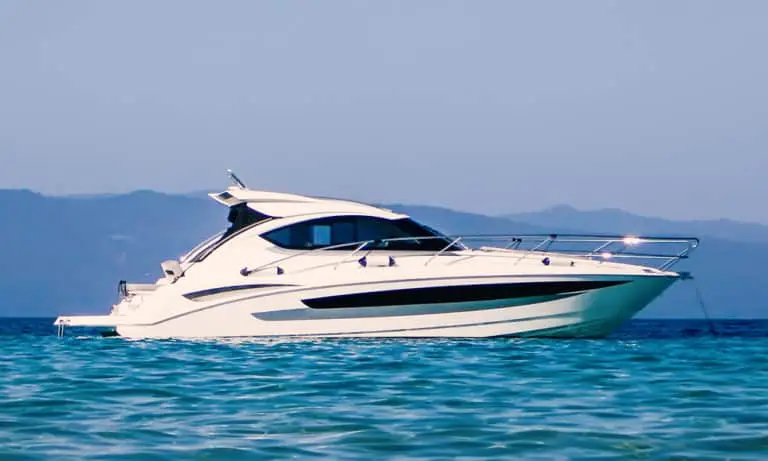
Boating Statistics in 2024 (incl. Covid & Millennials)
It’s no secret that Americans love boating as boating and fishing are the largest outdoor recreation activities in the U.S….
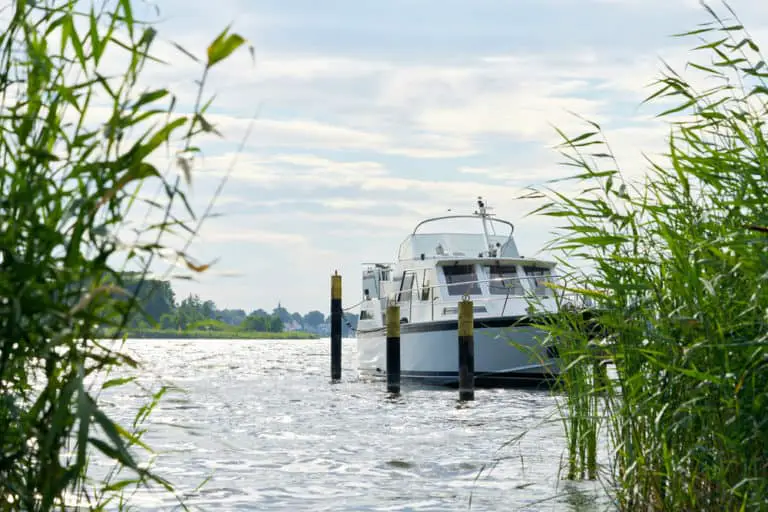
Do You Need a License to Drive a Boat in 2024? (U.S. & Canada)
It’s getting to be prime vacationing time, and if you’re traveling to enjoy some time on the water, you will…
![sailboat light at night 15 Tips for Boating at Night [for Safety & Navigation]](https://quicknav.com/wp-content/uploads/2021/09/Depositphotos_272396036_s-2019-768x510.jpg)
15 Tips for Boating at Night [for Safety & Navigation]
As a new boat owner, one of the activities you may be most excited about is your opportunity to experience…
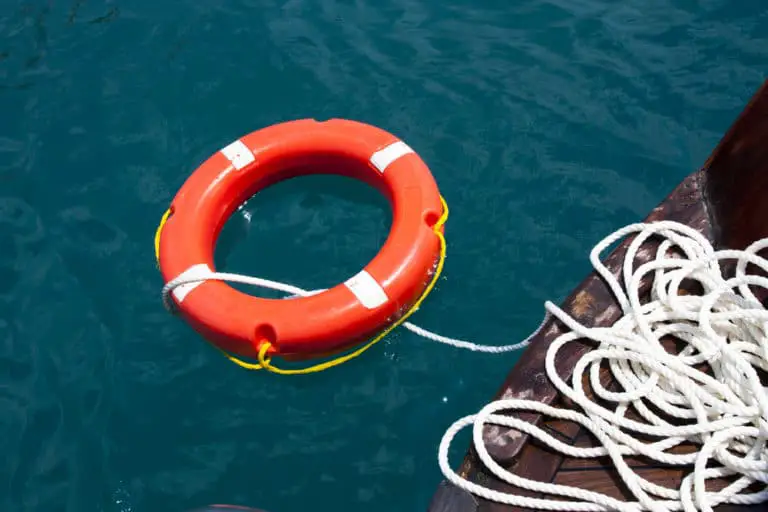

8 Best Online Boating Safety Courses (2024)
Boating can be one of the most enjoyable pastimes, but it can also be deadly. Being familiar with all aspects…
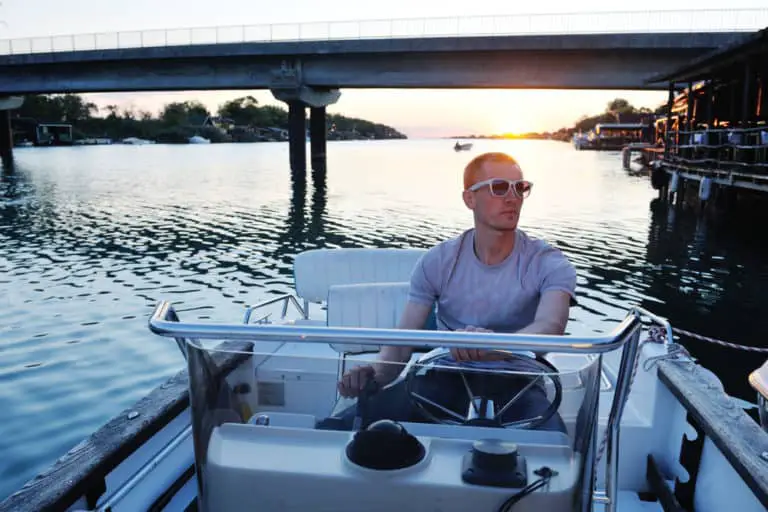
12 Practical Tips to Learn Boating Fast (2024)
For someone who wants to learn boating, it can be a bit intimidating looking from the outside in. You might…
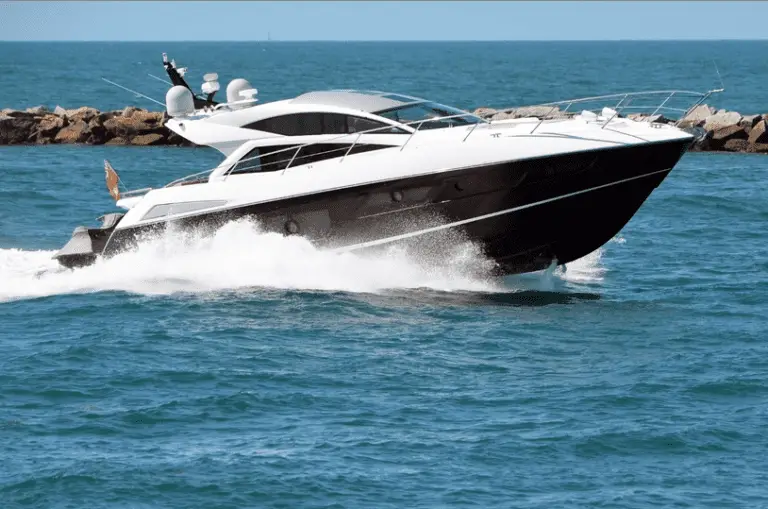
Cabin Cruiser: The Ultimate Guide (2024)
Passengers: Maximum 10Length: 20-40 FeetTrailerable: YesBest for: Day Cruising & Overnight TripsPrice Range: $100,000-$500,000Propulsion: 2+ Outboard Engines Many boaters want…

Navigation Lights for Sailboats (And How To Read Them)

Last Updated by
Capt Chris German
June 15, 2022
Navigation lights on a sailboat can be confusing. If you understand the reason behind why they are the way they are however, they can make a lot more sense.
At their heart, sailboats are really just a power boat and as such must adhere to all power boat rules such as navigation lights. Other times however, a sailboat is classified in a special category. They have a set of additional lights they CAN show as an option, but are not always required to do so.
That’s about as clear as mud if you ask me and I contend that that is where the confusion about lighting a sailboat begins.
Just because you can show a light to identify yourself in times of low visibility, does not mean you have to and then we add in a little sibling rivalry between power and sail and things get downright adversarial when it comes to navigation and the night.
Table of contents
The USCG says You’re a Power Boat Whether You Like It or Not
Much to the consternation of many a sailor who has earned a commercial license to drive their sailboat, when you received your credential from the USCG it says you are a master of steam and power across the top with no mention of wind as a source of propulsion.
It is not until you read the back pages of your little red book that feels like a passport and looks like a US Sailing credential, that you will see the term “sail auxiliary”. That is because most of the time the U.S. Coast Guard knows that you are primarily reliant on your mechanical power to propel your vessel.
It's a sad thing, but the days of commercially viable sail boats are done and all but the most select few even have sails let alone use them as their primary power source. All sail boats by law are powerboats, but not all powerboats are sailboats.
Navigation Lights for a Power Boat
As a power boat, you are required to show certain lights and have been required to do so before power was even invented.
In the days of man powered vessels like the viking ships who relied on oars while in close quarters to power their vessels, they needed to show other boats, friend or foe, where they were by showing lanterns in the dark to identify themselves. As you know, it is a time honored rule among all the nations of the world both past and present, that you must avoid a collision at all costs while at sea and even the viking knew that you should not run into things.
By lighting the front and back of your boat, you could warn other boats of your presence as well as identify which way you were heading. As such there is a very specific rule in the Code of Federal Regulations Number 46 (CFR46 by common name) that spells out with detail how many, the color, the luminosity or brightness, the angle of visibility and the location of all of the lights required for navigation on every single boat, seaplane, submarine and other nondescript vessel conceived by man to date that they must show while underway in reduced visibility.
And there is no flexibility in the rules.
As such a power boat, and by extension all sailboats, MUST, without question show one green light on the starboard bow and one red light on the port bow and one all around white light or lights while operating in reduced visibility. These lights should shine at all 360 degrees of visibility with the bow lights shining at an angle of dead ahead to 22.5 degrees abaft the beam and the stern lights shining 225 degrees dead aft. A forward facing masthead light that is white in color shall shine forward to comply with the directive that all vessels must carry an all around white light. For more read here .
As you can see, there isn’t much wiggle room when it comes to lights that must be shown.
Sailboats get a little flexibility with lights
Sailboats however, are a little different when they are in fact sailboats, which is only when you are entirely reliant on the wind for power and in no way reliant on any mechanical or manual means of propulsion. And for good reason.
Back in the day when men were men and sailboats were wooden, fire was a major concern. Sails were coated with wax and other flammable substances and the wood on boats was saturated with oils and grease. Even the ropes were plant materials saturated with oils to keep them pliable and strong.
Add those highly flammable substances to a parching environment like the sea and you had what was essentially a giant floating tinderbox.
Then tell that giant floating tinderbox that they need to identify themselves to the world at large at night using oil lamps with flames because batteries and lights were not invented yet. It didn't take very long or very many ships burning to the water line for the Governments to say to the sailboats, you get to do things a little different.
As such, sailboats are given special dispensation when it comes to lights aloft. They don't have to show an all around white light in their rigging because no one wanted to set their rig on fire with oil lamps 60 feet up in their rig.
However, when a sailboat takes their sails down such as when they are powered or at anchor, they must resume the display of an all around white light or lights aloft. That became a real challenge with aluminum masts and the disappearance of rat lines on the shrouds because there was no easy way to climb the rig and check the bulbs up the mast on a regular basis.
Red over Green Sailing Machine
I have no idea where the history of this particular light comes from, but if you ever take a deck exam with the USCG, you better remember this mnemonic. An all around red light over an all around green may be displayed on a vessel during times of reduced visibility to indicate that a vessel is operating under sail power alone.
I won’t even speculate on how or why they came up with this particular light configuration, but if you want to use these lights as a sailing vessel, you can do so, but that means that you will need three all round lights at the top of your mast, an all around white, an all around red and an all around green, just in that order.
The red over green is to be displayed in addition to the running lights or the red and green bow lights with the 225 degree stern light. As always, when the motor comes on, so does the steaming light or the forward facing white light that is also usually about ¾ of the way up on your mast to complete the requirement of an all around white light that indicates a power vessel.
What is a “steaming light” and why are you mentioning it now?
Most sailboat electrical panels will have a switch that is labelled “steaming light” and it will only come on when your anchor light is off. This is probably the most confusing part of sailboat navigation lights so if you are confused about this, you're in good company as most people are.
A “steaming” light is named thusly, going back to the days of steam powered sailboats where when they fired up their boilers and doused the sails, they became a power boat once again. There aren’t too many steam powered boats, let alone steam powered sailboats, but the name stuck and it is a vestige of a bygone era.
Either way, when you fire up your motor, you turn on your “steaming light” and that locks out the all around white light which is used for anchoring to minimize the number of switches on your panel and reduce the number of wires in your mast. The fewer wires, the less chance of something not working or becoming disconnected.
The steaming light and the anchor light both go up the mast, but you can’t use an all around white light while using the 225 degree stern light at the deck level because to other boaters you would look like you have two white lights from the stern and that would be confusing.
The anchor light is used exclusively for anchoring while the steaming light is used to indicate you are a power vessel while underway.
As to why I am mentioning it now in the article, is because this would have blown your mind if I started with this subject cause it can be really confusing stuff.
Aspect Recognition with Lights
Remember when I said earlier that lights can help you tell others which way you are heading as well as tell you which way other boats are heading? That is called the aspect of the vessel and the USCG tests you on this for your deck exam as well.
Knowing that the bow lights go 22.5 degrees abaft the beam on both sides or 112.5 degrees on each side, and the stern light faces 225 degrees aft for a total of 360 degrees of visibility, you can tell a lot about where a boat is heading and who has the right of way.
One thing that's easy to remember is red means stop and if you see a vessel's red light, it means stop as you are the give way vessel and approaching the other vessel from his port side. Conversely it works with green as well as that means you are approaching from the other vessel's starboard side and you are the standon vessel.
If you see a red and green light equally low on the horizon, that means your heading dead on into another vessel's path and conversely if all you see is a white light low on the horizon, it means you are overtaking another vessel power or sail, we don’t care because it is an overtaking situation. However, any time you do see a white light aloft in addition to the red and green bow lights, you know you are encountering a power boat.
Then there are angular approaches as well, where you see white and red or white and green light low on the horizon. You know in that case you are seeing a portion of the bow lights and stern lights from the side approaches of a vessel. Based on which direction those lights are heading, you can deduce which way that boat is going in relation to your boat.
So put it all together and you see a green light and a white light low on the horizon with a red over green light aloft, you know that you are approaching a sailboat that is traveling to your port and that might make you the standon vessel. That is of course, if we didn’t concern ourselves with windward and leeward and port tacks and starboard tacks, but that is a discussion for another article. So stay tuned when we talk about sailing rules and the right of way. But for now, do good, have fun and sail far.
Related Articles
Capt Chris German is a life long sailor and licensed captain who has taught thousands to sail over the last 20 years. In 2007, he founded a US Sailing-based community sailing school in Bridgeport, CT for inner city youth and families. When Hurricane Sandy forced him to abandon those efforts, he moved to North Carolina where he set out to share this love for broadcasting and sailing with a growing web-based television audience through The Charted Life Television Network.
by this author

Most Recent

What Does "Sailing By The Lee" Mean?
Daniel Wade
October 3, 2023

The Best Sailing Schools And Programs: Reviews & Ratings
September 26, 2023
Important Legal Info
Lifeofsailing.com is a participant in the Amazon Services LLC Associates Program, an affiliate advertising program designed to provide a means for sites to earn advertising fees by advertising and linking to Amazon. This site also participates in other affiliate programs and is compensated for referring traffic and business to these companies.
Similar Posts

How To Choose The Right Sailing Instructor
August 16, 2023

Cost To Sail Around The World
May 16, 2023

How To Drive A Pontoon Boat
Jacob Collier
December 19, 2022
Popular Posts

Best Liveaboard Catamaran Sailboats
December 28, 2023

Can a Novice Sail Around the World?
Elizabeth O'Malley

4 Best Electric Outboard Motors

How Long Did It Take The Vikings To Sail To England?

10 Best Sailboat Brands (And Why)
December 20, 2023

7 Best Places To Liveaboard A Sailboat
Get the best sailing content.
Top Rated Posts
Lifeofsailing.com is a participant in the Amazon Services LLC Associates Program, an affiliate advertising program designed to provide a means for sites to earn advertising fees by advertising and linking to Amazon. This site also participates in other affiliate programs and is compensated for referring traffic and business to these companies. (866) 342-SAIL
© 2024 Life of Sailing Email: [email protected] Address: 11816 Inwood Rd #3024 Dallas, TX 75244 Disclaimer Privacy Policy

Boat Navigation Light Rules: Sail Safely at Night
- Post author: [email protected]
- Post published: December 23, 2023
- Post category: Maritime
- Post comments: 0 Comments
Boat navigation light rules are essential for preventing collisions at night or in poor visibility conditions. These regulations dictate the color, position, and timing of lights displayed by boats.
Navigation lights serve two main purposes on a boat. They are the definite way to make your boat visible when you operate it at night or in low visibility weather to prevent collusion. The other thing is when two boats approximate each other, the navigation light indicates who has in the right way. However, these lights will only come in handy when you make the best use of them with navigation light rules. In this post, we’ve covered the basic rules for navigation lights.
Navigating waterways safely after dark requires a clear understanding of maritime lighting norms. Established by international and local maritime organizations, these rules mandate that vessels exhibit specific lights to indicate their size, type, and activity to other boaters—assuring clarity on the waters when visibility wanes.
Green lights denote the right side, red lights signal the left side, and white lights reveal a vessel’s presence and direction. Sailboats under power and all motorized boats must follow these guidelines to communicate their intentions and maintain safety at sea. Adherence to these protocols helps to prevent accidents and is a fundamental component of responsible boating. By mastering these rules, boaters contribute to a safer nautical environment for everyone navigating the waters.
Boat Navigation Light Rules – Key Takeaways
- Colored lights are always denoted as sidelight, Red light on the Port, and Green on the starboard. Red and green sidelights both shine from dead ahead to 112.5° aft (towards the stern) on each side.
- Stern lights are white and shine towards the stern (aft) and 67.5° forward on both sides. (Therefore, the stern light combined with the sidelight creates a full (360°) circle of light.
- All-round lights are white and shine constantly over the horizon by creating an arc of 360°.
- Masthead lights are white and installed over the fore and aft centreline on a vessel. This provides an unbroken light over an arc of the horizon of 225° forward, which signifies 112.5° on the port side through just ahead to 112.5° on the starboard side.
- Sailboats under power are recognized powerboats.
- During the day sailboats with sails up, but are also under power, are required to fly a black “steaming cone,” with its point downward, wherever it can be viewed. When a sailboat is under power it must follow the rules as like a powerboat.
Types Of Boat Navigation Lights
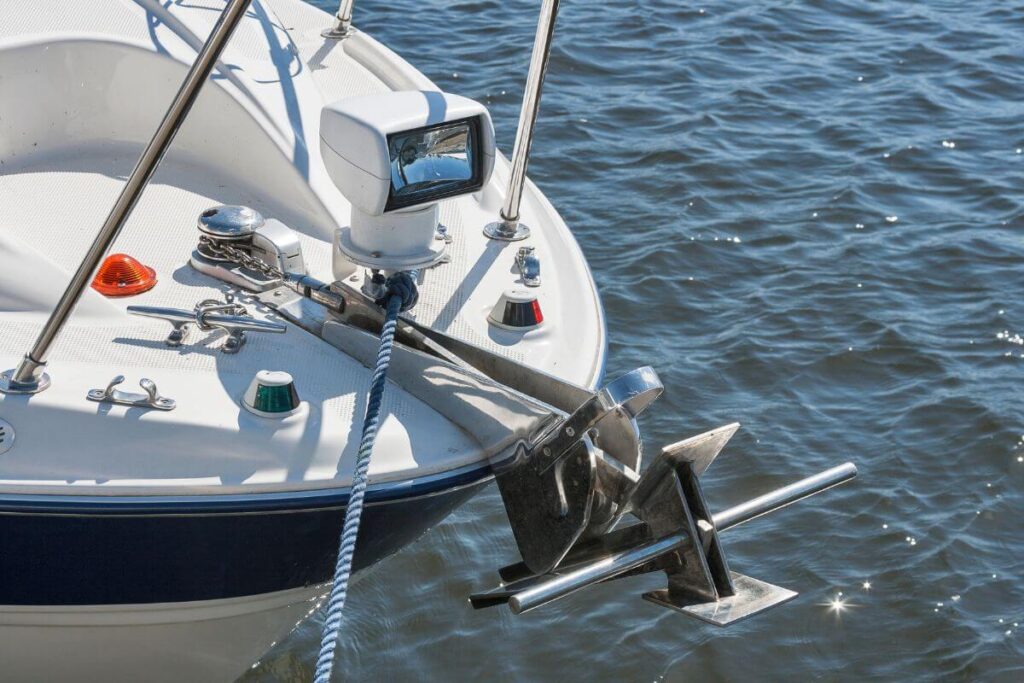
Navigating the waters safely means understanding the language of marine lighting. Just as traffic lights regulate the flow of cars, boat navigation lights help sailors avoid collisions and travel securely after dark. We’ll explore the essential lights that every seafarer needs to recognize.
Port (red) Navigation Lights
The left side of a vessel, referred to as the ‘port’ side, is designated by a red navigation light. This luminary serves as a positional marker, allowing other boaters to ascertain which direction a vessel is facing in relation to their own when meeting head-on or crossing paths.
- Visible from a distance, typically up to one nautical mile for smaller boats and two nautical miles for larger vessels.
- Should remain illuminated from sunset to sunrise and during periods of restricted visibility.
Starboard (green) Navigation Lights
On the opposite side, the ‘starboard’ side is indicated through a green navigation light. Its purpose mirrors that of the port light—to inform nearby boats which side they are seeing to prevent accidents.
- Similar in range to the red port light, starboard lights also span up to two nautical miles for larger vessels.
- Must be in operation from dusk until dawn and at times when visibility is poor.
Stern (white) Navigation Lights
Completing the critical trio of navigation lights is the stern light, a white light placed at the back of the boat. This light ensures that vessels are visible from behind and can safely be overtaken or crossed.
- Shines over a prescribed arc and is clearly visible over two nautical miles.
- Crucial during night hours and in low-visibility conditions, this light is a non-negotiable aspect of navigation safety.
Familiarity with these navigation light regulations is vital for all boaters to maintain safety and comply with international maritime laws. By following these guidelines, mariners can signal their intentions and position effectively, ensuring safer seas for everyone.
Rules And Regulations
Understanding the rules and regulations for boat navigation lights is crucial for ensuring the safety and compliance of maritime travel. Both international waters and inland waterways have distinct sets of regulations that sailors must adhere to. Navigation lights help in the prevention of collisions by alerting other vessels of your position, orientation, and status. This section provides a detailed overview of the regulations that govern boat navigation lighting.
International Rules
The International Regulations for Preventing Collisions at Sea (COLREGs) dictate the use of navigation lights for vessels on international waters. According to these rules:
- Power-driven vessels require a masthead light, sidelights, and a stern light.
- Sailing vessels under power must use the lighting configuration of power-driven vessels. When solely under sail, they should display sidelights and a stern light.
- Vessels at anchor display an all-round white light visible from all directions.
- Vessels under 7 meters may have reduced requirements in certain conditions.
All vessels must adhere to the specific color, range, and arc requirements for each light, ensuring visibility by other boats.
Inland Rules
For boats navigating in rivers, lakes, and other inland waterways, the United States Coast Guard (USCG) sets out their own rules which are:
- Different configurations for navigation lights are based on the type and size of the vessel.
- Rules for specific waterway types and conditions, including peri-urban waterways with increased traffic .
- Mandatory compliance with local and federal regulations which could involve additional lighting or signals .
The Inland Navigation Rules act in unison with COLREGs but have localized adjustments for the increased complexity of shallow and narrow channels.
Additional Considerations
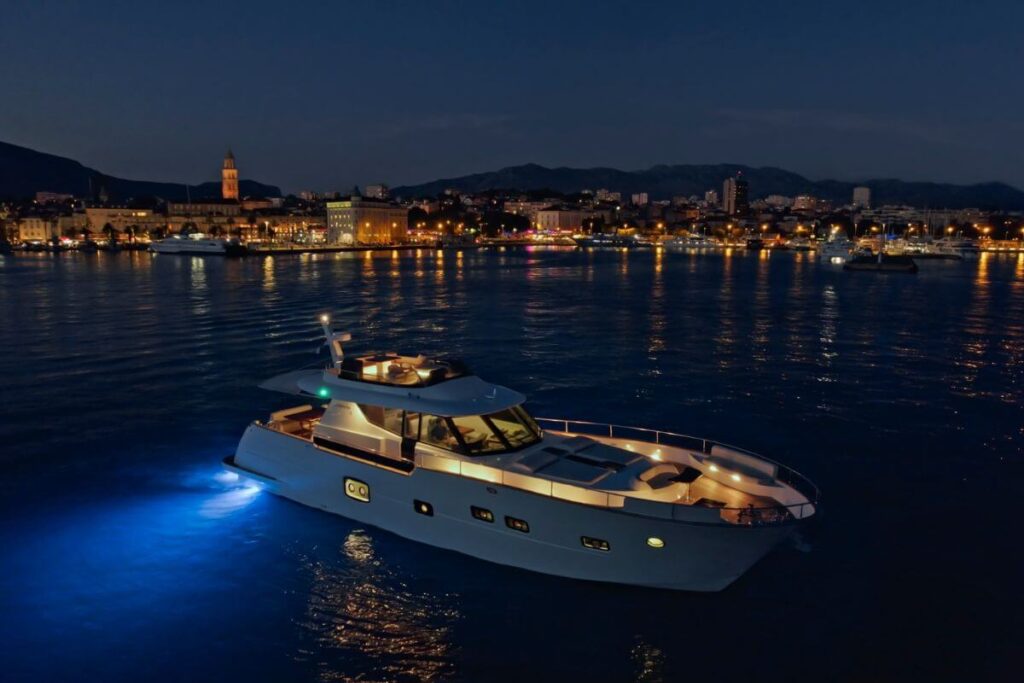
Beyond the standard regulations, there are additional considerations to keep in mind:
| Vessel Condition | Lighting Requirement |
|---|---|
| Restricted in ability to maneuver | All-round lights to indicate status |
| Engaged in fishing | Specific lights that signal other boats to keep clear |
| Towing operation | Additional lights to indicate towing length and breadth |
Proper interpretation and application of navigation light regulations are essential. Skippers should ensure their vessels comply with the latest regulations and be prepared to recognize the light configurations of other vessels to maintain safety on the water .
Frequently Asked Questions For Boat Navigation Light Rules
What are the requirements for navigation lights on a vessel.
Vessel navigation light requirements vary by size and type. All boats must display red (port) and green (starboard) sidelights. Power-driven vessels over 12 meters need a masthead light, sternlight, and all-around white light. Sailing vessels under 7 meters may use a lantern or flashlight in low visibility.
What Lights Are Required For Boats At Night?
At night, boats must display red and green sidelights and a white stern light. Boats under sail also need a red-over-green masthead light. All vessels are required to exhibit an all-round white light when at anchor.
What Are The Rules For Nautical Lights?
Nautical lights are governed by specific rules to ensure safety and communication at sea. Vessels must display lights that indicate their size, type, and activity. Red and green sidelights denote port and starboard, while white stern and masthead lights show direction and visibility to other ships. Compliance with the International Regulations for Preventing Collisions at Sea (COLREGs) is mandatory.
What Navigation Lights Are Required For Boats Under 23 Feet?
Boats under 23 feet need red and green sidelights and an all-round white light or a masthead light and sternlight visible from two miles away. Use sidelights in conjunction with the masthead and sternlight or the all-round white light.
Navigating the waters safely is essential for any boater. Understanding and following the boat navigation light rules is a key part of this. Ensuring your vessel is visible at night and during poor visibility conditions protects you and others at sea.
Navigation lights are the way to describe your position and movement in the water. By installing these lights and knowing the rules you can ensure the safety of your vessel and everyone else.
You Might Also Like

Electric Vessels | Future of The Most Advanced Shipping Industry

Autonomous Ships | Future of Maritime Industry
Leave a reply cancel reply.
Save my name, email, and website in this browser for the next time I comment.
- Members Forum
- Log In / Create Account
Navigation Lights at Night
by Harbor Sailboats | Dec 4, 2020 | Blog | 1 comment

Great article! Boat lights are the means of communication between sailing vessels. These lights are also a tool to let my presence known even from a distance.
Submit a Comment Cancel reply
You must be logged in to post a comment.
Latest Blog Posts
- Talk and Walk
- Sailing Lessons in San Diego
- Water in the Bilge
- Bow Standing
- Gear then Steer
Boat Reviews
- Boats Specs
- Marine Pros
- Boat Insurance
- Boat Warranties
- Boat Transport
- Boat Towing
- Marine Forecasts

Your Ultimate Boating Resource

What are the proper sailboat lights at night?
As a sailor, it is essential to be aware of and adhere to proper sailboat lighting when navigating at night. These lights are necessary to ensure safety and avoid collisions with other vessels.
The International Regulations for Preventing Collisions at Sea (COLREGS) specifies lighting requirements for different types of boats. There are different lighting rules for vessels under power and those under sail. In this article, we’ll discuss the proper sailboat lights at night.
Sailboats are required to have three lights at a minimum: a masthead light, a red port light, and a green starboard light. The masthead light is white and is located at the top of the mast. This light should shine forward and aft and be visible from 2 nautical miles away. It is important to ensure that the masthead light is not obstructed by the sail or any other structure onboard.
The red port light is located on the left or port side of the boat and is visible from 1 nautical mile away. The green starboard light is on the right or starboard side and is also visible from 1 nautical mile away. These lights should shine out from the vessel and be visible from dead ahead to 112.5 degrees abaft the beam on either side.
In addition to these lights, sailboats that are underway may show an optional stern light. This light is placed at the stern of the vessel and is white. It should be visible from 2 nautical miles away and can be used to indicate that the sailboat is underway and not at anchor.
If a sailboat is not underway but still poses a potential hazard, it should display an anchor light. This is a white light that is visible from 2 nautical miles away and should be located near the top of the mast. This light indicates that the sailboat is anchored and should be avoided by other vessels.
It is important to note that the visibility of the lights depends on the weather and other conditions. In foggy or hazy conditions, the lights may not be visible from the specified distance. It is always a good idea to maintain a lookout and be aware of other vessels in the vicinity.
Proper sailboat lighting at night is critical to ensuring safety and avoiding collisions with other boats. It is essential to understand the required lighting regulations and to ensure that all lights are functioning correctly before heading out on the water. Remember to always maintain a lookout and be aware of other vessels around you. Happy sailing!
Related Questions
What type of wood is used for pier pilings, what is the difference between a dock and a floating pier, what is the proper technique for pulling a beginner wakeboarder, what does ‘no wake’ mean on a lake, what is the difference between wash and wake, is wakesurfing possible in the sea, why don’t wooden piers rot, what size wakeboard is needed, how to achieve more pop on a wakeboard, does wake surfing translate to ocean surfing, latest posts, overview of the 2024 sea-doo rxp-x 325, overview of the 2024 parker offshore 2900 cc, what your boat’s beam is and why it matters, power cats of 2024: ultimate guide to the top power catamarans this year, don't miss, our newsletter.
Get the latest boating tips, fishing resources and featured products in your email from BoatingWorld.com!
Navigating the Heat: 10 Safety Tips for a Safe Boat Ride in the Summer Heat
Highs, lows, and tidal know-how: a deep dive into ocean currents, 10 essential tips for fishing near private property, the benefits of using a drift sock: guidance for anglers, lure fishing: secrets for imitating live bait and attracting fish, explore the untapped depths of america’s best bass fishing spots, outboard motor maintenance: tips for keeping your engine in top shape, the essential boat tool kit: tools every boater needs, diy boat building: 8 tips and tricks for building your own vessel, the art of miniature maritime craftsmanship: ship in a bottle, antifouling paints: a guide to keeping your boat shipshape, beginner’s guide to standup paddle boarding: tips and techniques, boating for fitness: how to stay active on the water, kayak safety: how to stay safe on the water, anchoring in a kayak or canoe: how to secure your small boat, overview of the 2024 yamaha 252sd, overview of the 2024 tiara yachts 48 le, overview of the 2024 bass cat jaguar sts, 2024 pursuit os 445: an overview, 2024 aquila 47 molokai review, 2024 sea-doo switch 13 sport review, gear reviews, megabass oneten max lbo jerkbait review, fortress anchors fx-7 anchoring system review, fortress anchors fx-11 anchoring system review, fortress anchors commando anchor kit review, fortress anchors aluminum anchors review, stay in touch.
To be updated with all the latest news, offers and special announcements.
- Privacy Policy

- Forums New posts Unanswered threads Register Top Posts Email
- What's new New posts New Posts (legacy) Latest activity New media
- Media New media New comments
- Boat Info Downloads Weekly Quiz Topic FAQ 10000boatnames.com
- Classifieds Sell Your Boat Used Gear for Sale
- Parts General Marine Parts Hunter Beneteau Catalina MacGregor Oday
- Help Terms of Use Monday Mail Subscribe Monday Mail Unsubscribe
How do you light your cockpit at night?
- Thread starter dserrell
- Start date Nov 7, 2009
- Forums for All Owners
- Ask All Sailors
Stu Jackson
Lights Our boat came equipped with incandescent cockpit lights mounted on the SS arch. Works well. We also use a lamp oil brass hanging lamp at times. Do not need much light. Thread
Don S/V ILLusion
Lighting the cockpit and lighting for compliance with nav rules are exclusive issues which you sound like you are mixing together - which are you talking about as you mention both David? Strictly for purpose of providing ambient light in the cockpit, I've found the only good way to create wide-area light is using string lights which can be found in either 110VAC or 12VDC varieties and conveniently strung inside the bimini or dodger bows using very little power.
Don S/V ILLusion said: Lighting the cockpit and lighting for compliance with nav rules are exclusive issues which you sound like you are mixing together - which are you talking about as you mention both David? Strictly for purpose of providing ambient light in the cockpit, I've found the only good way to create wide-area light is using string lights which can be found in either 110VAC or 12VDC varieties and conveniently strung inside the bimini or dodger bows using very little power. Click to expand
Warren Milberg
I use an parafin oil lamp that I hang from a small chain under the bimini. We also use this same lamp inside the cabin. Provides a nice warm glow and enough light to do most everything except read. Bought this lamp new from eBay and was shipped from India for a total cost of $29. One of the best bargains I ever had for the boat....
Attachments

Absent a hard top or bimini, mount a small 12v light permanently to the underside of the boom. On an open boat I sold this spring (Stiletto 27) I mounted a small utillity light purchased from Advanced Autoparts (I'm sure you could find something nice and marine, but I liked the shape of this one). I shaped a piece of starboard to match the curve of the mast (passed over a table saw blade at an angle), sawed and sanded it to match the base of the light, and mounted it to the boom with screws and 5200. The wires run inside the boom to the mast, are exposed for a few inches, and then run down the mast. It is on the cabin light circuit, but has its own switch on the side of the fixture. VERY handy. It looked like a factory install when finished. You won't be able to imagine a cockpit without instant light. Would you buy a car without a dome light?
for my anchor light non my formosa i have a beautiful old oil lamp- --i found some cheepo garden lights --solar powered---from an outlet that takes in returns from costco--so these are 4-6 dollars each--lol--excellent light and cheeep and i can use many --as many as i want...for use as lights at anchor....even indoors after charging them in the sun all day!!!! i love my oil light for anchor--has fresnel lens and is visible for over 3 miles---is approved for use as anchor lamp, btw......
Light your cockpit at night in Maine & you're mosquito bait!
Cockpit lighting We have a couple of Japanese style paper lanterns that run on AA batteries. I usually just string up one of those.
Re: Cockpit lighting I just use a kerosene lantern both for my anchor light and my cockpit light when I want it. The CG does not specify the type of light just the range of visibility and a 1/2 inch wick meets the needs.
Dan Johnson
Davis... makes a handy low wattage lamp with a fresnel lens and a cigarette plug connector that can be used as an anchor light. I slip a notched plastic cup over it and hang it from a bimini crossbar for a neat cockpit downlight. Also have LED utility lights in the cockpit footwell for safe footing at night when docked (too bright to sail with).
- This site uses cookies to help personalise content, tailor your experience and to keep you logged in if you register. By continuing to use this site, you are consenting to our use of cookies. Accept Learn more…
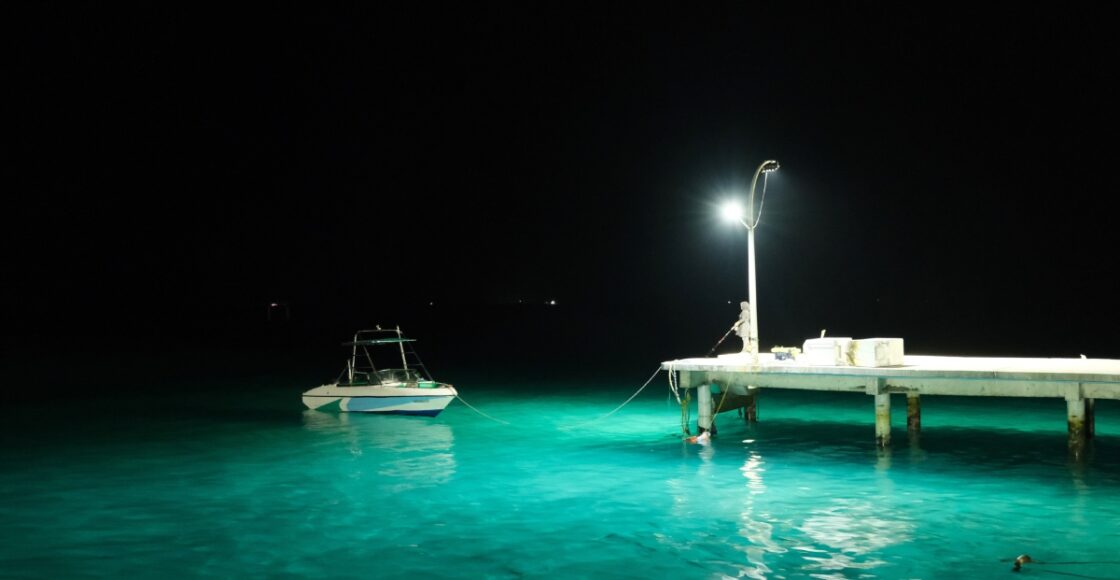
Night Fishing Guide: Essential Tips & Tricks
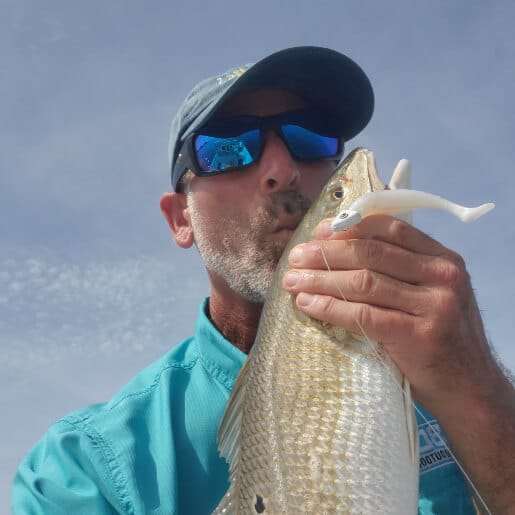
Table of Contents
Last Updated on August 29, 2024 by Boatsetter Team
When the night bite is the right bite, you’ll want to make sure you know the ins and outs of night fishing.
Whether you plan on prowling an inland lake in a bass boat or visiting one of the world’s top 10 saltwater fishing locations , there will be certain seasons when specific species are biting best at night. And night fishing can be very different from fishing in broad daylight—it requires some specific tackle and techniques, as well as some additional gear. You say you’re ready to hook up after the sun has sunk below the horizon? This guide will help you make it happen.
When to go Night Fishing
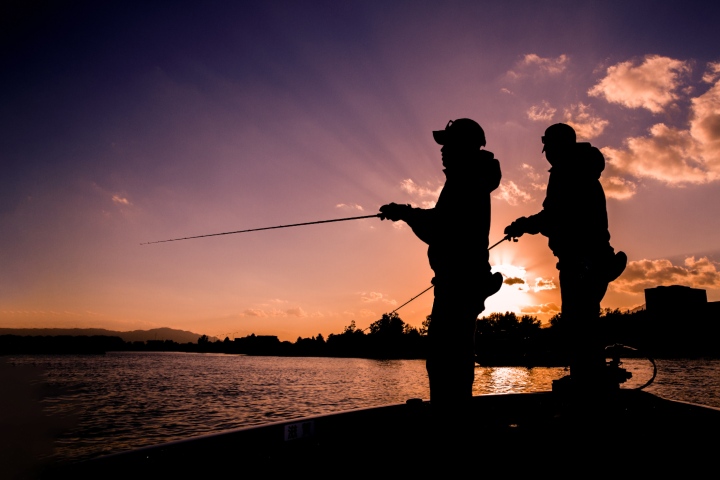
While night fishing is a top tactic at some times for some species, it isn’t always the case for all species. Flounder, for example, are known for feeding the strongest in bright daylight year-round. Many types of sharks feed more at night than they do during daylight through all of the seasons. Crappie feed during both night and day. And striped bass feed more at night during warm months of the year, but in many areas feed more during the day in the colder months of the year. All fish are different, and many vary their behavior by the season or the environment they’re in. So, the first step in deciding when to go night fishing requires some research on the specific species, time of year, and geographical area you’re in.
Once you know what’s biting and when, you can plan a night fishing trip. For many species in-the-dark activity ramps up with the moon phase, so to experience peak action you’ll want to try to time your adventure around the moon. Then, also consider the other environmental factors that always affect fishing: the wind , pressure changes, strong fronts moving through, and so on. Finally, remember that it’s always a good idea to start a trip before the sun sets. This allows you to get where you’re going and set up all your gear in daylight, when it’s much easier to do things like navigate a boat and tie knots in fishing line .
Gear for Night Fishing
The most critical item to have when night fishing is a headlamp. Not a flashlight but a headlamp, because you need hands-free illumination in order to see when you’re doing things like baiting hooks and undoing tangles. You should also have a powerful flashlight both as a backup and as a signaling device. Remember to dress warmer than you normally would since it can get chilly at night even during the summer months. And if you’ll be on a boat in open water it’s a good idea for everyone aboard to wear a life jacket . For an added measure of safety everyone can also slip a cyalume light stick into a pocket or attach one to a belt loop, so if anyone ends up in the drink they can hold it up and it’s easy to spot them.
There’s one more type of light you’ll want, but this one isn’t for you—it’s for the fish. An underwater light is great for attracting bait, which in turn attracts predators. In fact, for some forms of night fishing a submersible light is considered a must-have. Just which type you’ll want to opt for varies by the fishery, but as a general rule of thumb green lights attract the most bait and the brighter they are, the better.
Tactics for Night Fishing
The same tactics you use during the day will often work great at night, however, remember that in the darkness many species will be relying on senses other than sight to find their pray. So generally speaking, natural baits which put some scent into the water will out-fish artificials in the dark of night.
If you do choose to use artificials, although it sounds counterintuitive you’ll usually do the best with dark colored lures. Blacks, browns, and purples may be harder for us to see in the dark, but they block out what little light is available from above, creating a silhouette that the predators can spot as they peer up from below.
Night Fishing Tips
Take note of these top three night fishing tips, which hold true across the board for different species, seasons, and places.
- Don’t set up at dusk, wait 45 minutes, and then move because you aren’t getting bites. When the sun goes down there’s often a lull in the action which lasts for an hour or so as the fish adjust to the change from daylight to darkness. For that first hour of dark you really can’t count on a ton of action and if you don’t wait long enough you might be leaving a prime spot where they just haven’t started biting yet.
- If you’re in an area where there are consistent sources of artificial illumination, like lighted bridges or piers, make them the destination. Fish often get accustomed to congregating night after night in areas where manmade light makes it easier for them to feed.
- As a rule you’ll catch predators just outside of the artificial illumination more often than you will inside the lighted area. The “light line” where illumination fades out into darkness is where those hunters are prowling, so make that zone your target.
You say you don’t mind missing out on a few hours of sleep and you’ll do anything for a hot bite? Give night fishing a try. You’ll discover that at many times of the year in many places, the night bite is the right bite.

With over three decades of experience in marine journalism, Lenny Rudow has contributed to dozens of boating and fishing publications and websites ranging from BoatU.S. Magazine to BDOutdoors.com. Rudow is currently the Angler in Chief at Rudow’s FishTalk , he is a past president of Boating Writers International (BWI), a graduate of the Westlawn School of Yacht Design, and has won numerous BWI and OWAA writing awards.
Browse by experience

Explore articles
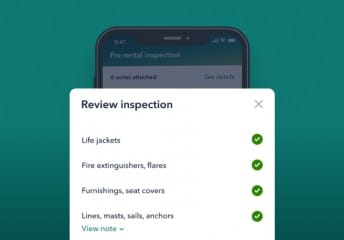
Check-in and Check-Out is Now Fully Digital

Things to Do at Lake Norman
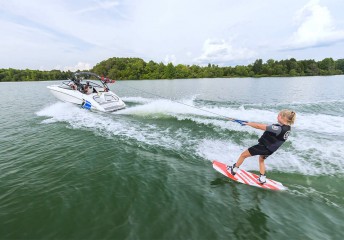
7 Ways to Spring into the Boating Fun
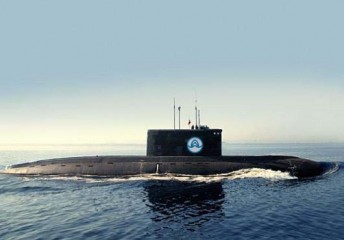
Ex-Soviet sub for rent! Underwater adventures available to aspiring boaters.
- Colorado Springs News
- Pueblo News
- Absolutely Colorado
- 13 Investigates
- On the Lookout
- School Buzz
- Body of Lies
- Funeral Home Investigation
- Identity Crisis: Olympic City USA
- Club Q: One Year Later
- Illicit Spas: Hiding In Plain Sight
- Black Forest Fire: 10 Years Later
- Waldo’s Inferno: 10 Years Later
- Closures & Delays
- Weather Maps and Forecasts
- Live HD Doppler
- Neighborhood Weather Network
- Viaero Wireless Network Cameras
- Weather Video
- Weather Photo Galleries
- Friday Night Blitz
- Live Newscasts
- Livestream Special Coverage
- Noticias KRDO13
- Telemundo Programacion
- KRDO NewsRadio Traffic
- Listen Live
- Radio Program Guide
- Radio Contests
- Pet of the Week
- Road Warrior
- Patriot Perks
- Traffic Tracker
- Healthy Colorado
- Breast Cancer Awareness
- Cooking Tips
- Next Chapter
- The Military Family
- Your House & Home
- Southern Colorado Jobs
- Wear Red Friday’s
- 2024 Voter Guide
- Broadcast Contests
- Entertainment
- Advertise with Us
- Contact KRDO
- Meet the Team
- Closed Captioning
- Download our Apps
- EEO Public Filing
- FCC Public File
- Newsletters/Alerts
- TV Listings
2 injured in boat explosion at New Jersey marina

By Katie Houlis, Naveen Dhaliwal
Click here for updates on this story
OLD BRIDGE, New Jersey ( WCBS ) — Two people were injured in a boat explosion at a New Jersey marina Wednesday afternoon.
Old Bridge Township Police said officers were sent to the Raritan Marina just before 3:30 p.m.
Video from Chopper 2 shows firefighters spraying water on a boat engulfed in flames in the creek. The flames sent plumes of black smoke billowing into the air.
According to police, the explosion caused a 57-year-old man to be launched into the water. Police said he was rescued by bystanders and airlifted to a local hospital to be treated for burns to his face and legs.
Police said a 47-year-old man was hit by glass and suffered injuries to his stomach and arms. He was taken to a local medical center for treatment.
The cause of the explosion is still being investigated, but police said it does not appear to be suspicious.
Wearing only a hospital gown, 47-year-old Michael Sorger returned to the marina Wednesday night.
“I’m here to live another day,” he said.
Sorger said he and a friend, who owned the boat, left Keyport for a fishing trip, then stopped at the Raritan Marina to gas up.
“We just put 75 gallons into the boat. I was anchoring it, and when he went to start it, it blew,” Sorger said.
In an instant, flames shot up in the air.
“The fire came across, gave me first degree burns to my stomach,” Sorger said. “The heat and everything was just outrageous.”
His friend was thrown into the water.
“I tried to pull him out the water,” Sorger said. “He was conscious. A lot of blood.”
The explosion happened in just seconds, but it changed Sorger’s life.
“Definitely take one life off of my nine lives,” he said.
Witnesses in the area said they could see the smoke and feel the blast.
“When we went down there, it was thick black smoke … lots of black smoke,” witness Danielle Fisher said.
Justin Cesare lives nearby and said his house shook.
“It was only for like three seconds, but it sounded like the house went down a foot … It was loud. I can’t explain it. It was crazy,” he said.
Please note: This content carries a strict local market embargo. If you share the same market as the contributor of this article, you may not use it on any platform.
Jump to comments ↓
CNN Newssource
KRDO NewsChannel 13 is committed to providing a forum for civil and constructive conversation.
Please keep your comments respectful and relevant. You can review our Community Guidelines by clicking here
If you would like to share a story idea, please submit it here .
- Central Oregon
- Decision 2024
- Oregon-Northwest
- Crime Stoppers
- KTVZ.COM Polls
- Special Reports
- Ask the Mayor
- Interactive Radar
- Local Forecast
- Road Conditions – Weather Webcams
- Livestream Newscasts
- Livestream Special Coverage
- Local Videos
- Photo Galleries
- 21 Cares For Kids
- Clear The Shelters
- Community Billboard
- Community Conversations
- Community Links
- One Class At a Time
- Pay it Forward
- House & Home
- Entertainment
- Events Calendar
- Pump Patrol
- 2024 Back 2 School Photos
- Show Us Your Garden 2024
- Central Oregon Backyard Living Photo Contest 2024
- Junior Forecaster
- Pet Pics Sweepstakes
- Sunrise Birthdays
- Submit Tips, Pics and Video
- KTVZ Careers
- Central Oregon Careers
- Email Newsletters
- Advertise with NPG of Oregon
- Careers and Internships
- Closed Captioning
- Download Our Apps
- EEO Public Filing
- FCC Public File
- NewsChannel 21 Team
- On-Air Status
- Receiving KTVZ
- TV Listings
Late-night boat party on Schuylkill River in Philadelphia ends when boat takes on water, police say
By Joe Brandt
Click here for updates on this story
PHILADELPHIA ( KDKA ) — About a dozen people were rescued from the Schuylkill River in Philadelphia early Thursday morning after a boat involved in a party started taking on water, police said.
Philadelphia police said they received a 911 call just before 12:30 a.m. from someone aboard a boat near the Platt Bridge by Philadelphia International Airport.
“There were actually two boats and they were together. There was about a total of 12 people, males and females in their 20s and 30s that were together on these two separate small boats,” Philadelphia police Chief Inspector Scott Small said.
“They were having some sort of party…one of them was taking on water, so they did the right thing, they stuck together, they called 911,” Small added.
Thankfully, everyone made it safely to dry land.
There was no word on what caused the issue with the boat.
It was yet another issue on the Schuylkill after a car plunged into the water upriver early Wednesday. Police said that incident occurred after people in the car were “enjoying each other’s company” before the vehicle started rolling into the river.
Please note: This content carries a strict local market embargo. If you share the same market as the contributor of this article, you may not use it on any platform.
Jump to comments ↓
CNN Newsource
Related articles.

Logging accident severely injures Oregon man

Mom suspicious after son’s body is found in Brooklyn creek. He’s the 3rd person found there in the past year

Philadelphia elementary school celebrates having air conditioning for first time in years

Rexburg man accused of buying second cell phone to look at child porn after police seize his first one
KTVZ NewsChannel 21 is committed to providing a forum for civil and constructive conversation.
Please keep your comments respectful and relevant. You can review our Community Guidelines by clicking here
If you would like to share a story idea, please submit it here .
3rd annual “Light Up The Fox” yachting event set for Saturday night
GREEN BAY, Wis. (WBAY) - Preparations are underway Saturday afternoon for the Green Bay Yachting Club’s third annual “Light Up The Fox” event.
The boat parade is free and open to the public for viewing. It starts at 9 p.m. on Saturday night.
Boaters will make their way from the mouth of the river through the Ray Nitschke Memorial Bridge on Main Street and the Bart Starr Memorial Bridge on Walnut Street bridge before looping back south.
The best places to watch, according to organizers?
The CityDeck, the Neville Public Museum, and Leicht Park.
Copyright 2024 WBAY. All rights reserved.

19-year-old dies at Green Bay prison; death considered a homicide

Luxemburg woman pleads guilty to child abuse

Manitowoc city inspectors’ discovery triggers emergency response to vacant property

2 dead, 1 hospitalized from West Nile Virus in Northeast Wisconsin

Shawano County man rescued after hours in Wolf River following crash

Oshkosh School Board votes against banning 6 books after Title IX discussion

The 10 healthiest and 10 unhealthiest fast-food sandwiches in America

Green Bay airport helps fans send Packers off to Brazil
Latest news.

WPS, We Energies charities hit big milestone in providing lifesaving equipment to first responders

State Joint Legislative Committee on Audit approves DPI audit.

SMALL TOWNS: Kiel couple finds joy in selling hostas

Milwaukee Bucks hit the road for statewide ‘Deer Crossing’ tour

Milwaukee Bucks hit the road for statewide 'Deer Crossing' tour

“Is this real?” Tree crashes into Kaukauna home during strong storm

18-year-old fatally struck by boat propeller in New Jersey, police say

Authorities in New Jersey are investigating a "tragic boating accident" that left a teenage girl dead.
Zeina Mahafzah, an 18-year-old, from Wayne, New Jersey, was attempting to board a boat from a raft being pulled by the boat in the waters off Sunset Park in Harvey Cedars, about an hour from Atlantic City, around 4:30 p.m. Sunday when she was struck by the vessel's propeller and fatally injured, New Jersey State Police said Monday.
Police said the incident was under investigation and no further information on the incident was immediately available.
While authorities did not share further details, NBC10 Philadelphia reported the boat was being driven by her father and multiple others were traumatized in the accident and were later evaluated by EMS.
Thoughts and prayers for family
Harvey Cedars Police Department, in post on X Sunday evening, said the department was investigating a "tragic boat accident off of Harvey Cedars in Long Beach Island" on Jersey Shore with the New Jersey State Police.
"As the investigation is in its preliminary stages, we ask that you keep the family and community in your thoughts and prayers," department had said in its post.
Saman Shafiq is a trending news reporter for USA TODAY. Reach her at [email protected] and follow her on X and Instagram @saman_shafiq7.

Sign in to add this item to your wishlist, follow it, or mark it as ignored

| Interface | Full Audio | Subtitles | English | ✔ | ✔ | ✔ | French | ✔ | ✔ | Italian | ✔ | ✔ | German | ✔ | ✔ | Spanish - Spain | ✔ | ✔ |
|---|---|---|---|
| Japanese | ✔ | ✔ | |
| Korean | ✔ | ✔ | |
| Polish | ✔ | ✔ | |
| Portuguese - Brazil | ✔ | ✔ | |
| Russian | ✔ | ✔ | |
| Simplified Chinese | ✔ | ✔ | |
| Traditional Chinese | ✔ | ✔ | |
| Turkish | ✔ | ✔ | |
| Spanish - Latin America | ✔ | ✔ |

Planned Release Date: 2025
About this game, system requirements.
- OS: Windows 10 64bit
- Processor: Intel Core i3-8100 or AMD Ryzen 5 2600X
- Memory: 8 GB RAM
- Graphics: NVIDIA GeForce GTX 1660 Super or AMD Radeon RX VEGA 56 or Intel Arc A750
- DirectX: Version 12
- Storage: 30 GB available space
- Processor: Intel Core i5-10400 or AMD Ryzen 5 3600
- Memory: 16 GB RAM
- Graphics: NVIDIA GeForce RTX 3070 Ti or AMD Radeon RX 6750 XT or Intel Arc A770
You can write your own review for this product to share your experience with the community. Use the area above the purchase buttons on this page to write your review.

You can use this widget-maker to generate a bit of HTML that can be embedded in your website to easily allow customers to purchase this game on Steam.
Enter up to 375 characters to add a description to your widget:
Copy and paste the HTML below into your website to make the above widget appear

Popular user-defined tags for this product: (?)
Sign in to add your own tags to this product.


IMAGES
VIDEO
COMMENTS
They must show an arc of 112.5 degrees from centerline of the bow. Stern light - A white light on the stern of the boat showing an unbroken arc of 135 degrees from centerline of the vessel. All-round light - A light showing in an unbroken arc of 360 degrees. The good news is you need not measure these angles.
On any vessel, navigation lights have a specific color, (white, red, green, yellow, blue), arc of illumination, range of visibility, and location, as required by law and regulations. For the purposes of this course, we will concentrate on pleasure boats under 65 feet in length. Knowledge of navigation lights is important to a small-boat skipper ...
Sailboat-Specific Navigation Light Rules. Sailboats must have the same red and green lights as powerboats. The difference is that you'll need other ones on the stern and mast. If your boat is less than 65 feet, you can use either a combination of a bicolor light with red and green along with another at the stern or a tricolor one on top of ...
The basic rule is that sidelights and a stern light are required. Permissible variations to this rule appear below. Sailboats less than 20m (65.7') can substitute a tricolor light for separate sidelights and stern light—or a bi-color light and a stern light may be substituted. Sailboats less than 7m (23') shall, if practicable, exhibit lights ...
Boat navigation lights at night are used for safety. They are designed so they can be seen easily. Boat lights vary according to boat type and size, boat use, navigation area, and geographic location. Boaters should learn boat light meanings and keep up-to-date on boat light requirements. Boat navigation lights indicate a boat's heading ...
==Short answer sailboat navigation lights:== Sailboat navigation lights are essential safety features that help vessels communicate and avoid collisions at night. These lights, such as the red and green sidelights and white stern light, allow sailors to determine the direction and status of approaching boats. Understanding the Importance of Sailboat Navigation LightsUnderstanding the Importance of
A properly lit sailboat at night is a boat that is equipped with the correct navigation lights, which are required by law. These lights must be visible for two miles and should include a green light on the starboard side, a red light on the port side, and a white light aft. Additionally, the boat must also have a white masthead light that is ...
Powerboat under 23 feet (7m) Powerboats under 23 feet are required to have the following navigation lights displayed: One white masthead light visible for 2 miles. One red & green sidelight visible for 1 mile. One stern light visible for 2 miles. One white, red, green, or yellow all-round light visible for 2 miles.
As such a power boat, and by extension all sailboats, MUST, without question show one green light on the starboard bow and one red light on the port bow and one all around white light or lights while operating in reduced visibility. These lights should shine at all 360 degrees of visibility with the bow lights shining at an angle of dead ahead ...
This light has to be mounted 39 inches or more above the sidelights. Powered Vessels of 40 Feet to 130 Feet. For a slightly larger boat, you will need the same red and green sidelights mentioned above. A white stern light is also required at the back of the boat. It should be seen from at least two miles away and visible at 135 degrees.
Boats less than 12 meters or 39.4 feet long: You'll need one red light and one green light at the front port and starboard sides of the boat for these boats. These lights should be positioned so that they can be seen at an angle of 112.5 degrees. The sidelights should be strong enough to be seen from a mile away.
Boat navigation light rules are essential for preventing collisions at night or in poor visibility conditions. These regulations dictate the color, position, and timing of lights displayed by boats. Navigation lights serve two main purposes on a boat. They are the definite way to make your boat visible when you operate it at night or […]
Side lights: a green light on the starboard side of the bow and a red light on the port side of the bow; Stern light: a white light at the stern; Masthead light: a white light affixed to the mast; Navigation light requirements for human-powered craft. Human-powered boats are required to display a white light that can be seen from all sides.
The starboard side light is green. When looking at the boat's transom or stern, a white light may be visible. Keep in mind large boats and ships may use other colors, like yellow. Next time you're boating at night, say thanks to your navigation lights. They allow you to see other boaters in the dark and help prevent collisions.
The most common of our navigation lights are our "running lights". This is a red light on the port side of the boat and a green light on the starboard side that shine from the bow to 22.5 degrees abaft the beam of the boat. This creates a 112.5-degree arc on either side of the vessel. To complete a 360-degree circle, our white stern light ...
Boat Navigation at Night: Head-on Approach. If you meet a vessel and see a green, red and white light, you are approaching another power-driven vessel head-on. ... flashlight or lighted lantern showing a white light (this rule applies if the boat cannot be equipped with standard navigation lights). 3) You are approaching an anchored craft at night.
In this article, we'll discuss the proper sailboat lights at night. Sailboats are required to have three lights at a minimum: a masthead light, a red port light, and a green starboard light. The masthead light is white and is located at the top of the mast. This light should shine forward and aft and be visible from 2 nautical miles away.
Common Navigation Lights. Navigation lights help you and other boaters determine which is the give-way vessel when encountering each other at night. These lights must be displayed from sunset to sunrise and during periods of restricted visibility, such as fog. There are four common navigation lights. Sidelights: These red and green lights are ...
Using Lights at Night. Depending on your intended use, you may have more flexibility in where and how you add lighting to your boat. The main thing to keep in mind is that the primary purpose of navigational lights is for other boats to be able to see you and interpret your heading and intent. As long as that requirement is met, additional ...
An effective way to safely sail at night is to shine a light on your sail if you hear a powerboat. You will be readily visible to other boaters. Larger sailboats should have lights similar to the powered boat lights on the side and the aft, but there could also have a tri-color light on the masthead that can be visible up to 2 miles away. ...
Navigation lights must be displayed on a boat if you are operating your boat at night or in poor visibility. The term "night" here refers to the period between sunset and daybreak. During the daytime, poor visibility can refer to heavy fog or even inclement weather, such as rain or snowfall. In this article, Drive a Boat Canada explains all ...
Red and green sidelights, one sternlight, and two all-round lights in a vertical line (upper red, lower green) also meet the navigation lights requirement for sailboats that are not operating under engine power (Rule 25). One combination red, green, and white light exhibited near the top of the mast meets the navigation lights requirement for ...
makes a handy low wattage lamp with a fresnel lens and a cigarette plug connector that can be used as an anchor light. I slip a notched plastic cup over it and hang it from a bimini crossbar for a neat cockpit downlight. Also have LED utility lights in the cockpit footwell for safe footing at night when docked (too bright to sail with). 1 1.
Whether you plan on prowling an inland lake in a bass boat or visiting one of the world's top 10 saltwater fishing locations, there will be certain seasons when specific species are biting best at night. And night fishing can be very different from fishing in broad daylight—it requires some specific tackle and techniques, as well as some ...
OLD BRIDGE, New Jersey — Two people were injured in a boat explosion at a New Jersey marina Wednesday afternoon.Old Bridge Township Police said officers were sent to the Raritan Marina just ...
Philadelphia police said they received a 911 call just before 12:30 a.m. from someone aboard a boat near the Platt Bridge by Philadelphia International Airport. "There were actually two boats ...
GREEN BAY, Wis. (WBAY) - Preparations are underway Saturday afternoon for the Green Bay Yachting Club's third annual "Light Up The Fox" event. The boat parade is free and open to the public ...
Authorities in New Jersey are investigating a "tragic boating accident" that left a teenage girl dead. Zeina Mahafzah, an 18-year-old, from Wayne, New Jersey, was attempting to board a boat from a ...
According to the Associated Press, the boat has been available for charter for $215,000 (€195,000) per week. Lynch's wife is linked to the yacht. The Bayesian is held by the company Revtom ...
An escapism-themed plot takes inspiration from the game Firewatch, while the visuals and atmosphere are influenced by Alan Wake. WILL: Follow The Light features unusual but intuitive game mechanics against an enthralling backdrop of epic northern scenery. You will find yourself sailing between remote islands and uncharted waters.